Commercial Cookery
VerifiedAdded on 2023/02/01
|22
|5760
|90
AI Summary
This document provides information on commercial cookery, including ingredients, dietary principles, food allergies, and dietary restrictions. It covers topics such as sugar substitutes, types of nutrients, food additives, dietary restrictions in different religions, and specialized diets for various health conditions.
Contribute Materials
Your contribution can guide someone’s learning journey. Share your
documents today.
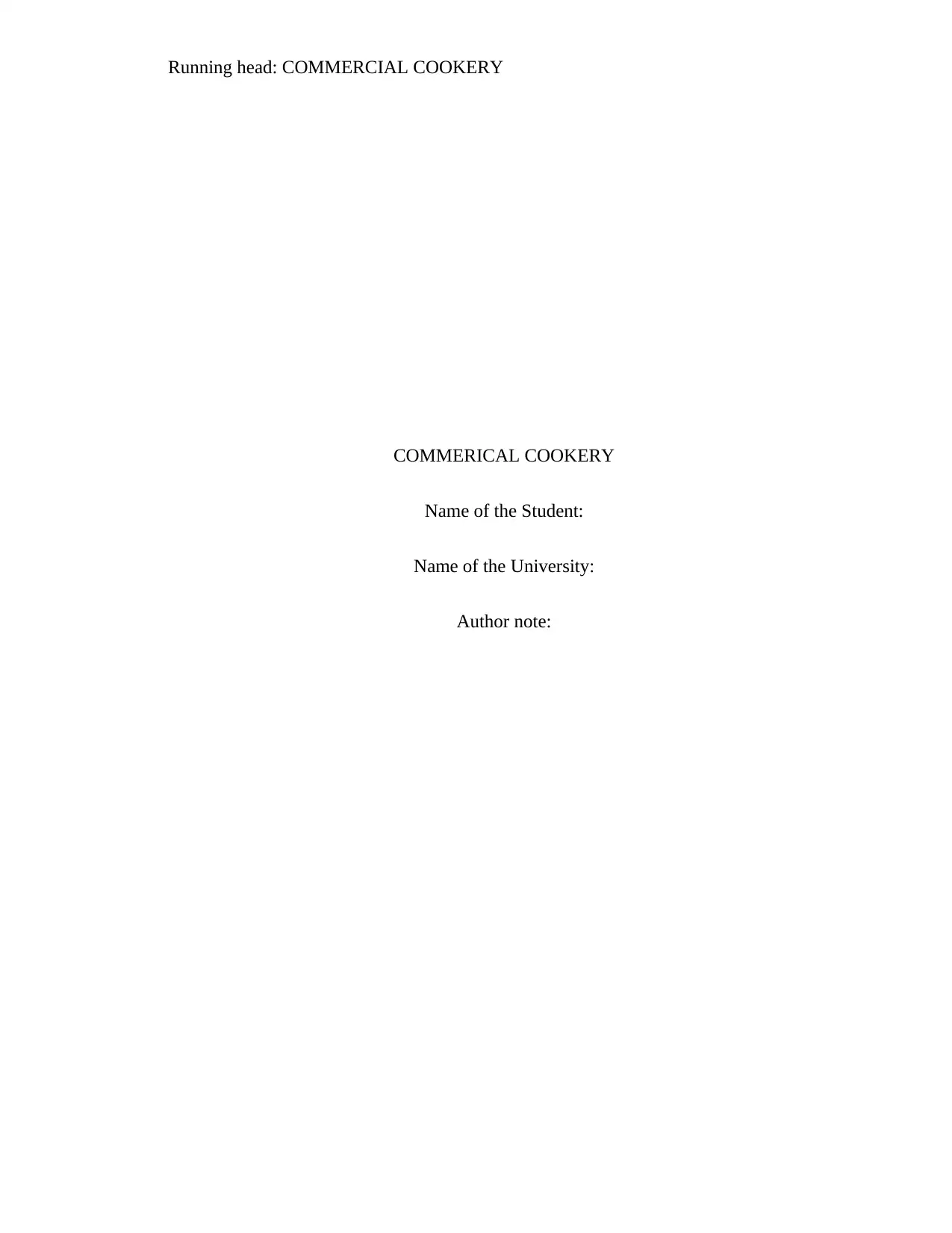
Running head: COMMERCIAL COOKERY
COMMERICAL COOKERY
Name of the Student:
Name of the University:
Author note:
COMMERICAL COOKERY
Name of the Student:
Name of the University:
Author note:
Secure Best Marks with AI Grader
Need help grading? Try our AI Grader for instant feedback on your assignments.

1COMMERCIAL COOKERY
Question 1
1. Sugar: Honey, Agave (for vegans), maple syrup, sugar, artificial sugar substitutes such
as aspartame, acesulfame, hgh fructose corn syrup and sucrose (Swithers 2016).
2. Milk: Soy milk, nut milk varieties such as those from almond, hazelnut, cashew, Coconut
milk (Mäkinen et al. 2016).
3. Egg: Bananas, apple sauce, avocado, chia seeds, aquafaba, buttermilk, yogurt, arrowroot,
flaxseeds, baking soda, silken tofu vinegar (Wojtusik et al. 2018).
Question 2
1. Carbohydrates, for energy: Whole grains such as wheat flour, corn, rice, barley, breads,
quinoa, millets, biscuits and sugars like fruits apples, mangoes, kiwis, bananas.
2. Proteins, for muscle growth development and tissue repair, such as milk and milk
products like cheese and yogurt, beans, pulses and legumes, leans meats like fish,
chicken, eggs, beef, turkey.
3. Fats, for energy, nervous functioning and joint lubrication, from oils, butter, oilseeds
like sesame, mustard and nuts like almonds, walnuts, cashews and peanuts.
4. Vitamins and Minerals, for antioxidants and healthy immunity such as fruits and
vegetables, and oils from fatty fish like salmon, halibut, trout and sardines.
5. Fiber for healthy bowel movements, from foods like whole grains, nuts, oilseeds, green
leafy vegetables and fruits like guava, apples and citrus fruits. Fluids for regulatory
functions, hydration, maintenance of cellular fluids and electrolytes, from water, soups,
Question 1
1. Sugar: Honey, Agave (for vegans), maple syrup, sugar, artificial sugar substitutes such
as aspartame, acesulfame, hgh fructose corn syrup and sucrose (Swithers 2016).
2. Milk: Soy milk, nut milk varieties such as those from almond, hazelnut, cashew, Coconut
milk (Mäkinen et al. 2016).
3. Egg: Bananas, apple sauce, avocado, chia seeds, aquafaba, buttermilk, yogurt, arrowroot,
flaxseeds, baking soda, silken tofu vinegar (Wojtusik et al. 2018).
Question 2
1. Carbohydrates, for energy: Whole grains such as wheat flour, corn, rice, barley, breads,
quinoa, millets, biscuits and sugars like fruits apples, mangoes, kiwis, bananas.
2. Proteins, for muscle growth development and tissue repair, such as milk and milk
products like cheese and yogurt, beans, pulses and legumes, leans meats like fish,
chicken, eggs, beef, turkey.
3. Fats, for energy, nervous functioning and joint lubrication, from oils, butter, oilseeds
like sesame, mustard and nuts like almonds, walnuts, cashews and peanuts.
4. Vitamins and Minerals, for antioxidants and healthy immunity such as fruits and
vegetables, and oils from fatty fish like salmon, halibut, trout and sardines.
5. Fiber for healthy bowel movements, from foods like whole grains, nuts, oilseeds, green
leafy vegetables and fruits like guava, apples and citrus fruits. Fluids for regulatory
functions, hydration, maintenance of cellular fluids and electrolytes, from water, soups,
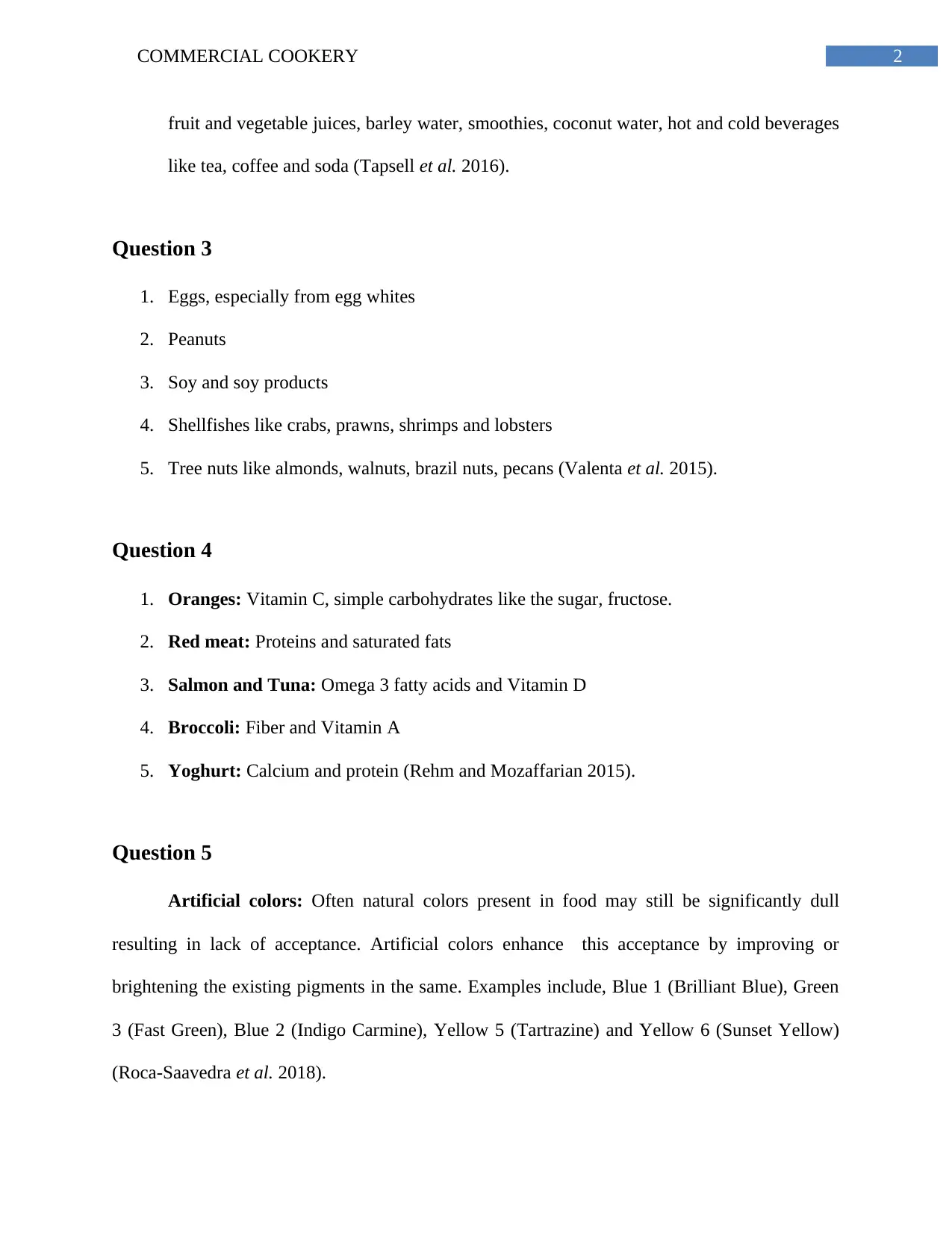
2COMMERCIAL COOKERY
fruit and vegetable juices, barley water, smoothies, coconut water, hot and cold beverages
like tea, coffee and soda (Tapsell et al. 2016).
Question 3
1. Eggs, especially from egg whites
2. Peanuts
3. Soy and soy products
4. Shellfishes like crabs, prawns, shrimps and lobsters
5. Tree nuts like almonds, walnuts, brazil nuts, pecans (Valenta et al. 2015).
Question 4
1. Oranges: Vitamin C, simple carbohydrates like the sugar, fructose.
2. Red meat: Proteins and saturated fats
3. Salmon and Tuna: Omega 3 fatty acids and Vitamin D
4. Broccoli: Fiber and Vitamin A
5. Yoghurt: Calcium and protein (Rehm and Mozaffarian 2015).
Question 5
Artificial colors: Often natural colors present in food may still be significantly dull
resulting in lack of acceptance. Artificial colors enhance this acceptance by improving or
brightening the existing pigments in the same. Examples include, Blue 1 (Brilliant Blue), Green
3 (Fast Green), Blue 2 (Indigo Carmine), Yellow 5 (Tartrazine) and Yellow 6 (Sunset Yellow)
(Roca-Saavedra et al. 2018).
fruit and vegetable juices, barley water, smoothies, coconut water, hot and cold beverages
like tea, coffee and soda (Tapsell et al. 2016).
Question 3
1. Eggs, especially from egg whites
2. Peanuts
3. Soy and soy products
4. Shellfishes like crabs, prawns, shrimps and lobsters
5. Tree nuts like almonds, walnuts, brazil nuts, pecans (Valenta et al. 2015).
Question 4
1. Oranges: Vitamin C, simple carbohydrates like the sugar, fructose.
2. Red meat: Proteins and saturated fats
3. Salmon and Tuna: Omega 3 fatty acids and Vitamin D
4. Broccoli: Fiber and Vitamin A
5. Yoghurt: Calcium and protein (Rehm and Mozaffarian 2015).
Question 5
Artificial colors: Often natural colors present in food may still be significantly dull
resulting in lack of acceptance. Artificial colors enhance this acceptance by improving or
brightening the existing pigments in the same. Examples include, Blue 1 (Brilliant Blue), Green
3 (Fast Green), Blue 2 (Indigo Carmine), Yellow 5 (Tartrazine) and Yellow 6 (Sunset Yellow)
(Roca-Saavedra et al. 2018).
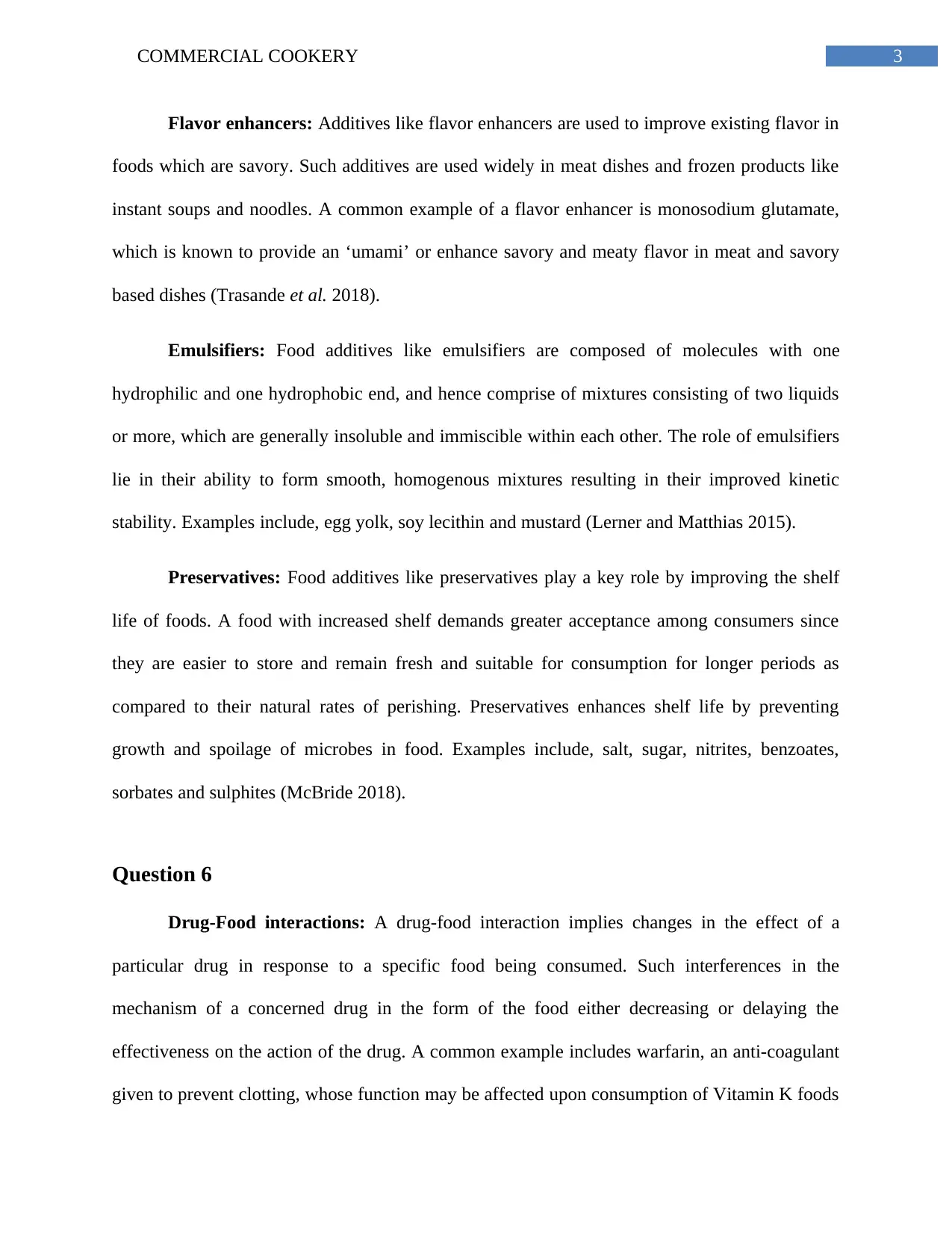
3COMMERCIAL COOKERY
Flavor enhancers: Additives like flavor enhancers are used to improve existing flavor in
foods which are savory. Such additives are used widely in meat dishes and frozen products like
instant soups and noodles. A common example of a flavor enhancer is monosodium glutamate,
which is known to provide an ‘umami’ or enhance savory and meaty flavor in meat and savory
based dishes (Trasande et al. 2018).
Emulsifiers: Food additives like emulsifiers are composed of molecules with one
hydrophilic and one hydrophobic end, and hence comprise of mixtures consisting of two liquids
or more, which are generally insoluble and immiscible within each other. The role of emulsifiers
lie in their ability to form smooth, homogenous mixtures resulting in their improved kinetic
stability. Examples include, egg yolk, soy lecithin and mustard (Lerner and Matthias 2015).
Preservatives: Food additives like preservatives play a key role by improving the shelf
life of foods. A food with increased shelf demands greater acceptance among consumers since
they are easier to store and remain fresh and suitable for consumption for longer periods as
compared to their natural rates of perishing. Preservatives enhances shelf life by preventing
growth and spoilage of microbes in food. Examples include, salt, sugar, nitrites, benzoates,
sorbates and sulphites (McBride 2018).
Question 6
Drug-Food interactions: A drug-food interaction implies changes in the effect of a
particular drug in response to a specific food being consumed. Such interferences in the
mechanism of a concerned drug in the form of the food either decreasing or delaying the
effectiveness on the action of the drug. A common example includes warfarin, an anti-coagulant
given to prevent clotting, whose function may be affected upon consumption of Vitamin K foods
Flavor enhancers: Additives like flavor enhancers are used to improve existing flavor in
foods which are savory. Such additives are used widely in meat dishes and frozen products like
instant soups and noodles. A common example of a flavor enhancer is monosodium glutamate,
which is known to provide an ‘umami’ or enhance savory and meaty flavor in meat and savory
based dishes (Trasande et al. 2018).
Emulsifiers: Food additives like emulsifiers are composed of molecules with one
hydrophilic and one hydrophobic end, and hence comprise of mixtures consisting of two liquids
or more, which are generally insoluble and immiscible within each other. The role of emulsifiers
lie in their ability to form smooth, homogenous mixtures resulting in their improved kinetic
stability. Examples include, egg yolk, soy lecithin and mustard (Lerner and Matthias 2015).
Preservatives: Food additives like preservatives play a key role by improving the shelf
life of foods. A food with increased shelf demands greater acceptance among consumers since
they are easier to store and remain fresh and suitable for consumption for longer periods as
compared to their natural rates of perishing. Preservatives enhances shelf life by preventing
growth and spoilage of microbes in food. Examples include, salt, sugar, nitrites, benzoates,
sorbates and sulphites (McBride 2018).
Question 6
Drug-Food interactions: A drug-food interaction implies changes in the effect of a
particular drug in response to a specific food being consumed. Such interferences in the
mechanism of a concerned drug in the form of the food either decreasing or delaying the
effectiveness on the action of the drug. A common example includes warfarin, an anti-coagulant
given to prevent clotting, whose function may be affected upon consumption of Vitamin K foods
Secure Best Marks with AI Grader
Need help grading? Try our AI Grader for instant feedback on your assignments.
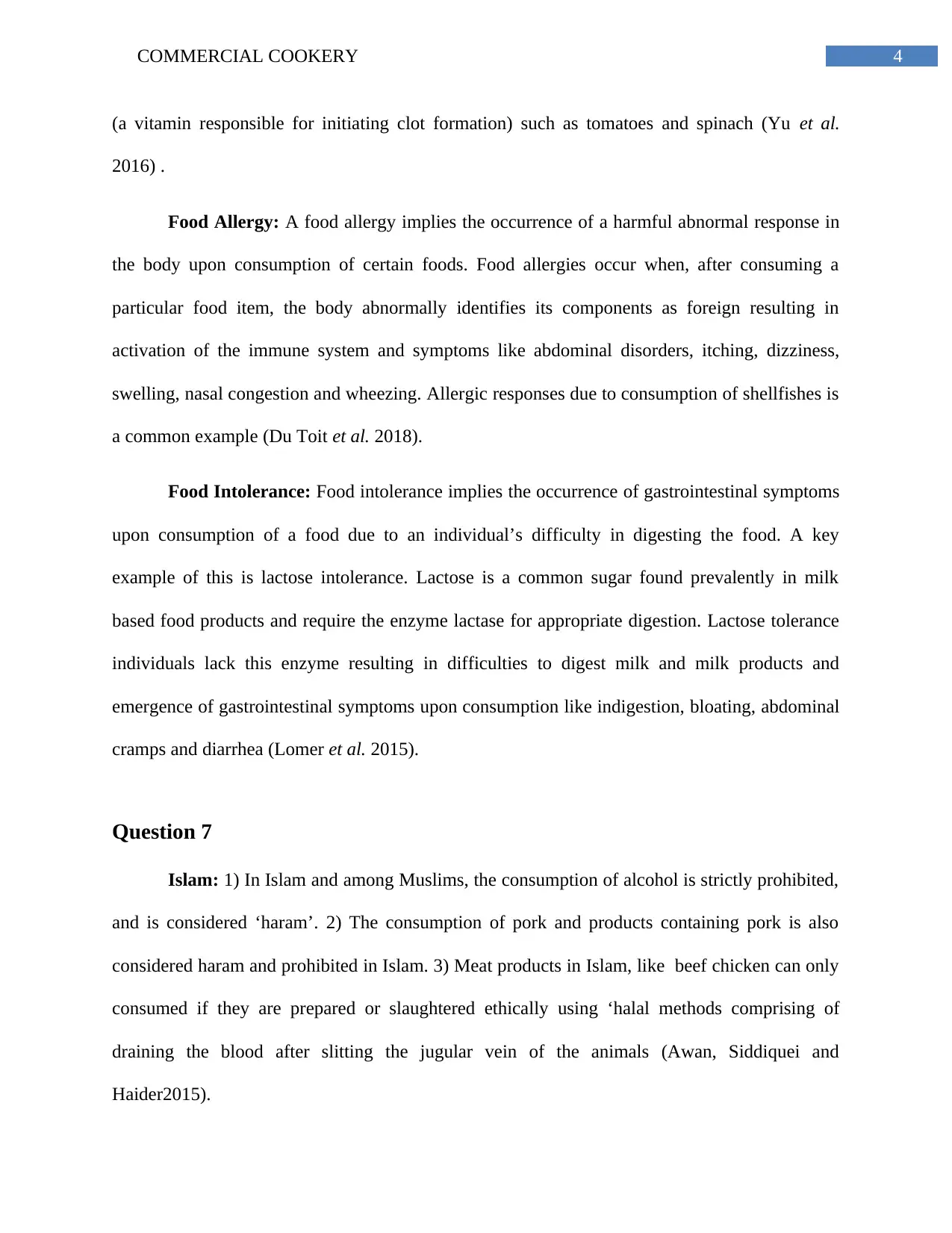
4COMMERCIAL COOKERY
(a vitamin responsible for initiating clot formation) such as tomatoes and spinach (Yu et al.
2016) .
Food Allergy: A food allergy implies the occurrence of a harmful abnormal response in
the body upon consumption of certain foods. Food allergies occur when, after consuming a
particular food item, the body abnormally identifies its components as foreign resulting in
activation of the immune system and symptoms like abdominal disorders, itching, dizziness,
swelling, nasal congestion and wheezing. Allergic responses due to consumption of shellfishes is
a common example (Du Toit et al. 2018).
Food Intolerance: Food intolerance implies the occurrence of gastrointestinal symptoms
upon consumption of a food due to an individual’s difficulty in digesting the food. A key
example of this is lactose intolerance. Lactose is a common sugar found prevalently in milk
based food products and require the enzyme lactase for appropriate digestion. Lactose tolerance
individuals lack this enzyme resulting in difficulties to digest milk and milk products and
emergence of gastrointestinal symptoms upon consumption like indigestion, bloating, abdominal
cramps and diarrhea (Lomer et al. 2015).
Question 7
Islam: 1) In Islam and among Muslims, the consumption of alcohol is strictly prohibited,
and is considered ‘haram’. 2) The consumption of pork and products containing pork is also
considered haram and prohibited in Islam. 3) Meat products in Islam, like beef chicken can only
consumed if they are prepared or slaughtered ethically using ‘halal methods comprising of
draining the blood after slitting the jugular vein of the animals (Awan, Siddiquei and
Haider2015).
(a vitamin responsible for initiating clot formation) such as tomatoes and spinach (Yu et al.
2016) .
Food Allergy: A food allergy implies the occurrence of a harmful abnormal response in
the body upon consumption of certain foods. Food allergies occur when, after consuming a
particular food item, the body abnormally identifies its components as foreign resulting in
activation of the immune system and symptoms like abdominal disorders, itching, dizziness,
swelling, nasal congestion and wheezing. Allergic responses due to consumption of shellfishes is
a common example (Du Toit et al. 2018).
Food Intolerance: Food intolerance implies the occurrence of gastrointestinal symptoms
upon consumption of a food due to an individual’s difficulty in digesting the food. A key
example of this is lactose intolerance. Lactose is a common sugar found prevalently in milk
based food products and require the enzyme lactase for appropriate digestion. Lactose tolerance
individuals lack this enzyme resulting in difficulties to digest milk and milk products and
emergence of gastrointestinal symptoms upon consumption like indigestion, bloating, abdominal
cramps and diarrhea (Lomer et al. 2015).
Question 7
Islam: 1) In Islam and among Muslims, the consumption of alcohol is strictly prohibited,
and is considered ‘haram’. 2) The consumption of pork and products containing pork is also
considered haram and prohibited in Islam. 3) Meat products in Islam, like beef chicken can only
consumed if they are prepared or slaughtered ethically using ‘halal methods comprising of
draining the blood after slitting the jugular vein of the animals (Awan, Siddiquei and
Haider2015).
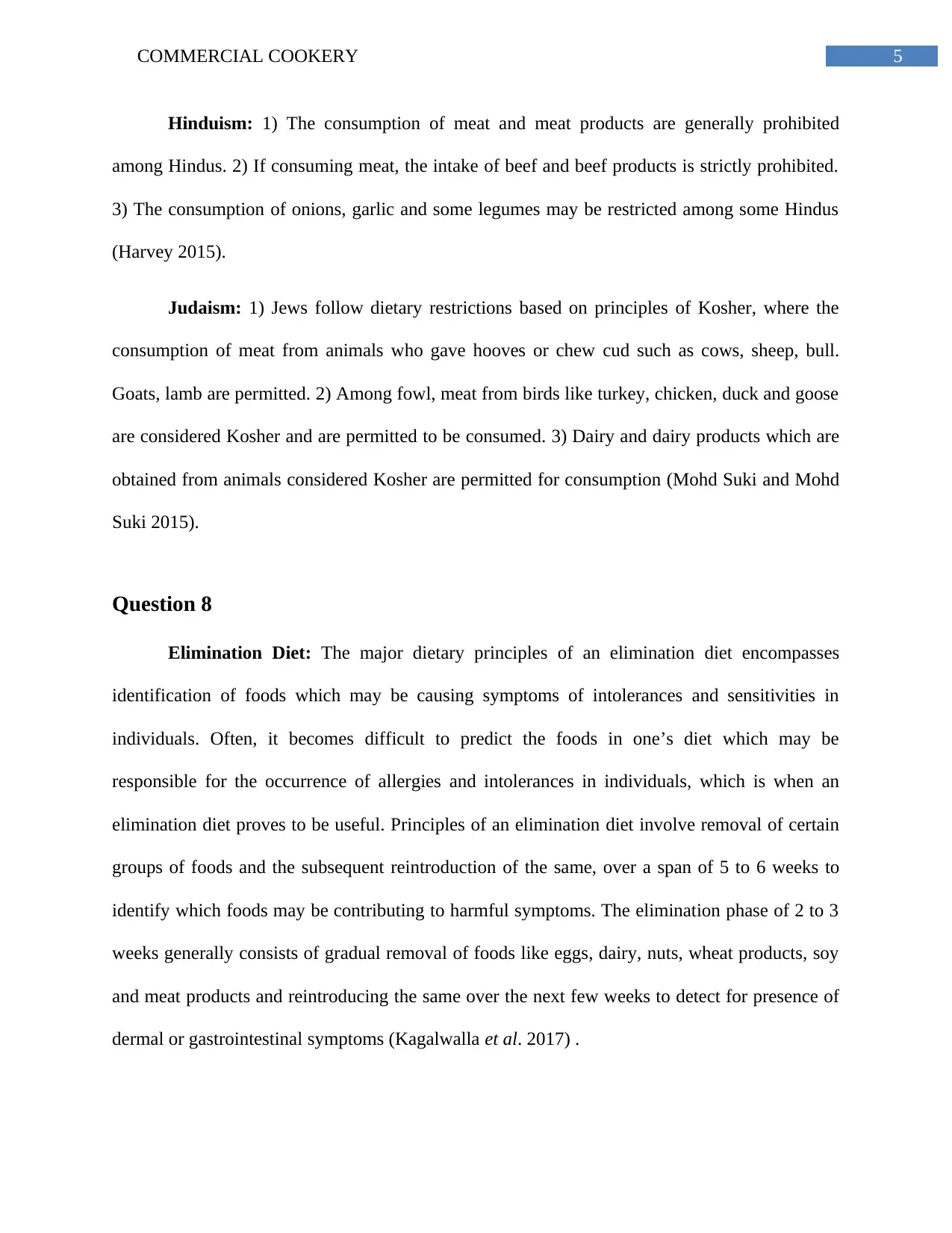
5COMMERCIAL COOKERY
Hinduism: 1) The consumption of meat and meat products are generally prohibited
among Hindus. 2) If consuming meat, the intake of beef and beef products is strictly prohibited.
3) The consumption of onions, garlic and some legumes may be restricted among some Hindus
(Harvey 2015).
Judaism: 1) Jews follow dietary restrictions based on principles of Kosher, where the
consumption of meat from animals who gave hooves or chew cud such as cows, sheep, bull.
Goats, lamb are permitted. 2) Among fowl, meat from birds like turkey, chicken, duck and goose
are considered Kosher and are permitted to be consumed. 3) Dairy and dairy products which are
obtained from animals considered Kosher are permitted for consumption (Mohd Suki and Mohd
Suki 2015).
Question 8
Elimination Diet: The major dietary principles of an elimination diet encompasses
identification of foods which may be causing symptoms of intolerances and sensitivities in
individuals. Often, it becomes difficult to predict the foods in one’s diet which may be
responsible for the occurrence of allergies and intolerances in individuals, which is when an
elimination diet proves to be useful. Principles of an elimination diet involve removal of certain
groups of foods and the subsequent reintroduction of the same, over a span of 5 to 6 weeks to
identify which foods may be contributing to harmful symptoms. The elimination phase of 2 to 3
weeks generally consists of gradual removal of foods like eggs, dairy, nuts, wheat products, soy
and meat products and reintroducing the same over the next few weeks to detect for presence of
dermal or gastrointestinal symptoms (Kagalwalla et al. 2017) .
Hinduism: 1) The consumption of meat and meat products are generally prohibited
among Hindus. 2) If consuming meat, the intake of beef and beef products is strictly prohibited.
3) The consumption of onions, garlic and some legumes may be restricted among some Hindus
(Harvey 2015).
Judaism: 1) Jews follow dietary restrictions based on principles of Kosher, where the
consumption of meat from animals who gave hooves or chew cud such as cows, sheep, bull.
Goats, lamb are permitted. 2) Among fowl, meat from birds like turkey, chicken, duck and goose
are considered Kosher and are permitted to be consumed. 3) Dairy and dairy products which are
obtained from animals considered Kosher are permitted for consumption (Mohd Suki and Mohd
Suki 2015).
Question 8
Elimination Diet: The major dietary principles of an elimination diet encompasses
identification of foods which may be causing symptoms of intolerances and sensitivities in
individuals. Often, it becomes difficult to predict the foods in one’s diet which may be
responsible for the occurrence of allergies and intolerances in individuals, which is when an
elimination diet proves to be useful. Principles of an elimination diet involve removal of certain
groups of foods and the subsequent reintroduction of the same, over a span of 5 to 6 weeks to
identify which foods may be contributing to harmful symptoms. The elimination phase of 2 to 3
weeks generally consists of gradual removal of foods like eggs, dairy, nuts, wheat products, soy
and meat products and reintroducing the same over the next few weeks to detect for presence of
dermal or gastrointestinal symptoms (Kagalwalla et al. 2017) .

6COMMERCIAL COOKERY
Macrobiotic Diet: A macrobiotic diet is generally recommended to be beneficial for
patients suffering from cancer, and its principles are based on the maintenance of Buddhism
components of yin and yang. Hence, dietary principles of the macrobiotic diet comprise of
consuming foods which maintain a balance of yin and yang or contractiveness and
expansiveness. Foods like whole grains like quinoa, rye, spelt and brown rice are considered to
be balanced while vegetables like peppers, tomatoes, eggplant, potatoes, avocadoes, beets and
spinach are recommended to be used negligibly. Occasionally foods like nuts, fishes, seafood,
beverages, sweeteners and seasonings may also be consumed (Falluca et al. 2015) .
Question 9
1. Any products of wheat such as wheat flours or products containing or prepared from the
same must be strictly avoided.
2. Derivatives of wheat such as barley, triticale and barley.
3. Oats must also be avoided strictly since they may be grown in the same agricultural area
as wheat.
4. Malted products must be avoided such as malted milk, malted barley flour, malt
flavoring, malt syrup and malt extracts.
5. Brewer’s Yeast
6. Additional products of wheat like durum, spelt, semolina, faro, graham and farina (Vici,
Belli, Biondi and Polzonetti 2016).
Macrobiotic Diet: A macrobiotic diet is generally recommended to be beneficial for
patients suffering from cancer, and its principles are based on the maintenance of Buddhism
components of yin and yang. Hence, dietary principles of the macrobiotic diet comprise of
consuming foods which maintain a balance of yin and yang or contractiveness and
expansiveness. Foods like whole grains like quinoa, rye, spelt and brown rice are considered to
be balanced while vegetables like peppers, tomatoes, eggplant, potatoes, avocadoes, beets and
spinach are recommended to be used negligibly. Occasionally foods like nuts, fishes, seafood,
beverages, sweeteners and seasonings may also be consumed (Falluca et al. 2015) .
Question 9
1. Any products of wheat such as wheat flours or products containing or prepared from the
same must be strictly avoided.
2. Derivatives of wheat such as barley, triticale and barley.
3. Oats must also be avoided strictly since they may be grown in the same agricultural area
as wheat.
4. Malted products must be avoided such as malted milk, malted barley flour, malt
flavoring, malt syrup and malt extracts.
5. Brewer’s Yeast
6. Additional products of wheat like durum, spelt, semolina, faro, graham and farina (Vici,
Belli, Biondi and Polzonetti 2016).
Paraphrase This Document
Need a fresh take? Get an instant paraphrase of this document with our AI Paraphraser
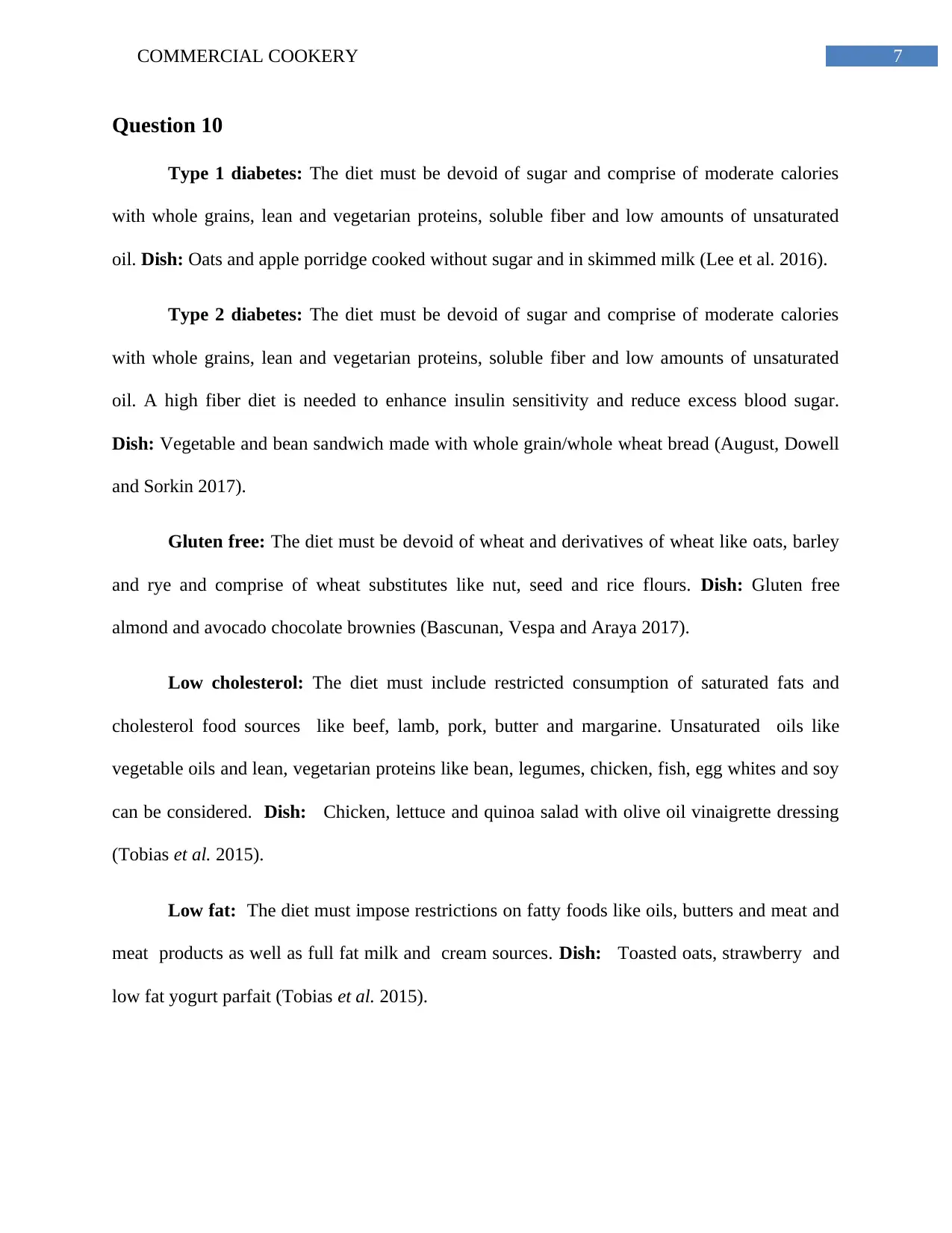
7COMMERCIAL COOKERY
Question 10
Type 1 diabetes: The diet must be devoid of sugar and comprise of moderate calories
with whole grains, lean and vegetarian proteins, soluble fiber and low amounts of unsaturated
oil. Dish: Oats and apple porridge cooked without sugar and in skimmed milk (Lee et al. 2016).
Type 2 diabetes: The diet must be devoid of sugar and comprise of moderate calories
with whole grains, lean and vegetarian proteins, soluble fiber and low amounts of unsaturated
oil. A high fiber diet is needed to enhance insulin sensitivity and reduce excess blood sugar.
Dish: Vegetable and bean sandwich made with whole grain/whole wheat bread (August, Dowell
and Sorkin 2017).
Gluten free: The diet must be devoid of wheat and derivatives of wheat like oats, barley
and rye and comprise of wheat substitutes like nut, seed and rice flours. Dish: Gluten free
almond and avocado chocolate brownies (Bascunan, Vespa and Araya 2017).
Low cholesterol: The diet must include restricted consumption of saturated fats and
cholesterol food sources like beef, lamb, pork, butter and margarine. Unsaturated oils like
vegetable oils and lean, vegetarian proteins like bean, legumes, chicken, fish, egg whites and soy
can be considered. Dish: Chicken, lettuce and quinoa salad with olive oil vinaigrette dressing
(Tobias et al. 2015).
Low fat: The diet must impose restrictions on fatty foods like oils, butters and meat and
meat products as well as full fat milk and cream sources. Dish: Toasted oats, strawberry and
low fat yogurt parfait (Tobias et al. 2015).
Question 10
Type 1 diabetes: The diet must be devoid of sugar and comprise of moderate calories
with whole grains, lean and vegetarian proteins, soluble fiber and low amounts of unsaturated
oil. Dish: Oats and apple porridge cooked without sugar and in skimmed milk (Lee et al. 2016).
Type 2 diabetes: The diet must be devoid of sugar and comprise of moderate calories
with whole grains, lean and vegetarian proteins, soluble fiber and low amounts of unsaturated
oil. A high fiber diet is needed to enhance insulin sensitivity and reduce excess blood sugar.
Dish: Vegetable and bean sandwich made with whole grain/whole wheat bread (August, Dowell
and Sorkin 2017).
Gluten free: The diet must be devoid of wheat and derivatives of wheat like oats, barley
and rye and comprise of wheat substitutes like nut, seed and rice flours. Dish: Gluten free
almond and avocado chocolate brownies (Bascunan, Vespa and Araya 2017).
Low cholesterol: The diet must include restricted consumption of saturated fats and
cholesterol food sources like beef, lamb, pork, butter and margarine. Unsaturated oils like
vegetable oils and lean, vegetarian proteins like bean, legumes, chicken, fish, egg whites and soy
can be considered. Dish: Chicken, lettuce and quinoa salad with olive oil vinaigrette dressing
(Tobias et al. 2015).
Low fat: The diet must impose restrictions on fatty foods like oils, butters and meat and
meat products as well as full fat milk and cream sources. Dish: Toasted oats, strawberry and
low fat yogurt parfait (Tobias et al. 2015).
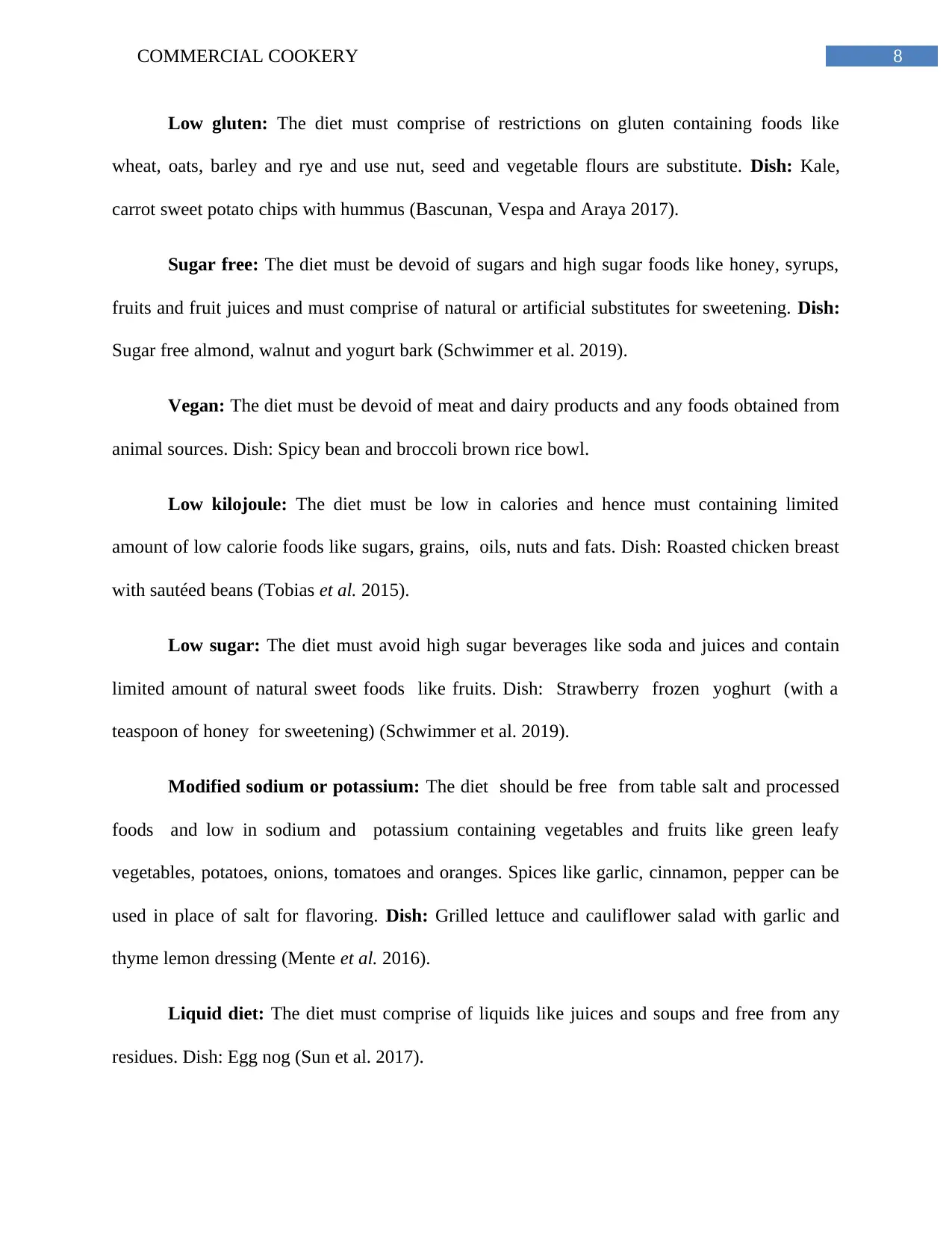
8COMMERCIAL COOKERY
Low gluten: The diet must comprise of restrictions on gluten containing foods like
wheat, oats, barley and rye and use nut, seed and vegetable flours are substitute. Dish: Kale,
carrot sweet potato chips with hummus (Bascunan, Vespa and Araya 2017).
Sugar free: The diet must be devoid of sugars and high sugar foods like honey, syrups,
fruits and fruit juices and must comprise of natural or artificial substitutes for sweetening. Dish:
Sugar free almond, walnut and yogurt bark (Schwimmer et al. 2019).
Vegan: The diet must be devoid of meat and dairy products and any foods obtained from
animal sources. Dish: Spicy bean and broccoli brown rice bowl.
Low kilojoule: The diet must be low in calories and hence must containing limited
amount of low calorie foods like sugars, grains, oils, nuts and fats. Dish: Roasted chicken breast
with sautéed beans (Tobias et al. 2015).
Low sugar: The diet must avoid high sugar beverages like soda and juices and contain
limited amount of natural sweet foods like fruits. Dish: Strawberry frozen yoghurt (with a
teaspoon of honey for sweetening) (Schwimmer et al. 2019).
Modified sodium or potassium: The diet should be free from table salt and processed
foods and low in sodium and potassium containing vegetables and fruits like green leafy
vegetables, potatoes, onions, tomatoes and oranges. Spices like garlic, cinnamon, pepper can be
used in place of salt for flavoring. Dish: Grilled lettuce and cauliflower salad with garlic and
thyme lemon dressing (Mente et al. 2016).
Liquid diet: The diet must comprise of liquids like juices and soups and free from any
residues. Dish: Egg nog (Sun et al. 2017).
Low gluten: The diet must comprise of restrictions on gluten containing foods like
wheat, oats, barley and rye and use nut, seed and vegetable flours are substitute. Dish: Kale,
carrot sweet potato chips with hummus (Bascunan, Vespa and Araya 2017).
Sugar free: The diet must be devoid of sugars and high sugar foods like honey, syrups,
fruits and fruit juices and must comprise of natural or artificial substitutes for sweetening. Dish:
Sugar free almond, walnut and yogurt bark (Schwimmer et al. 2019).
Vegan: The diet must be devoid of meat and dairy products and any foods obtained from
animal sources. Dish: Spicy bean and broccoli brown rice bowl.
Low kilojoule: The diet must be low in calories and hence must containing limited
amount of low calorie foods like sugars, grains, oils, nuts and fats. Dish: Roasted chicken breast
with sautéed beans (Tobias et al. 2015).
Low sugar: The diet must avoid high sugar beverages like soda and juices and contain
limited amount of natural sweet foods like fruits. Dish: Strawberry frozen yoghurt (with a
teaspoon of honey for sweetening) (Schwimmer et al. 2019).
Modified sodium or potassium: The diet should be free from table salt and processed
foods and low in sodium and potassium containing vegetables and fruits like green leafy
vegetables, potatoes, onions, tomatoes and oranges. Spices like garlic, cinnamon, pepper can be
used in place of salt for flavoring. Dish: Grilled lettuce and cauliflower salad with garlic and
thyme lemon dressing (Mente et al. 2016).
Liquid diet: The diet must comprise of liquids like juices and soups and free from any
residues. Dish: Egg nog (Sun et al. 2017).

9COMMERCIAL COOKERY
Yeast Free: The diet should be free from yeast and baked goods like breads must contain
yeast substitutes like sodium bicarbonate. Dish: Irish soda bread buttermilk muffins (Morreale,
Benavent-Gil. and Rosell 2019).
Question 11
a) Ingredients which may cause health consequences due to allergies in the food item
include: egg, milk, gluten containing cereals and trace amounts of tree nuts and
crustaceans acquired from its area of processing.
b) This dish is not suitable for individuals suffering from gluten or lactose intolerances or
from allergies of milk, eggs, nuts and wheat. The dish is also not suitable for diabetics,
renal patients or those suffering from cardiovascular ailments. The dish is also not
suitable for followers of Hinduism.
c) The dish is not for low salt diets since it contained high amounts, 1080 g of sodium. It is
also not suitable for low carbohydrate diets since it contains high amounts that is 56 gm
of carbohydrates and 10 gm of sugars. The dish is not suitable for a low fat diet since it
contains saturated fat sources like cheese and beef and comprises of 14.4. gm of fat. The
dish may be suitable for a high protein diet since it provides 37.6% of daily protein intake
and contains high protein foods like beef, milk products and cheese.
Question 12
Anaphylaxis or anaphylactic shock implies the emergence of life threatening symptoms
due to the body’s abnormal response upon consumption of a particular food item. Anaphylaxis is
prevalent especially after consumption of foods which are potentially allergic and triggers an
Yeast Free: The diet should be free from yeast and baked goods like breads must contain
yeast substitutes like sodium bicarbonate. Dish: Irish soda bread buttermilk muffins (Morreale,
Benavent-Gil. and Rosell 2019).
Question 11
a) Ingredients which may cause health consequences due to allergies in the food item
include: egg, milk, gluten containing cereals and trace amounts of tree nuts and
crustaceans acquired from its area of processing.
b) This dish is not suitable for individuals suffering from gluten or lactose intolerances or
from allergies of milk, eggs, nuts and wheat. The dish is also not suitable for diabetics,
renal patients or those suffering from cardiovascular ailments. The dish is also not
suitable for followers of Hinduism.
c) The dish is not for low salt diets since it contained high amounts, 1080 g of sodium. It is
also not suitable for low carbohydrate diets since it contains high amounts that is 56 gm
of carbohydrates and 10 gm of sugars. The dish is not suitable for a low fat diet since it
contains saturated fat sources like cheese and beef and comprises of 14.4. gm of fat. The
dish may be suitable for a high protein diet since it provides 37.6% of daily protein intake
and contains high protein foods like beef, milk products and cheese.
Question 12
Anaphylaxis or anaphylactic shock implies the emergence of life threatening symptoms
due to the body’s abnormal response upon consumption of a particular food item. Anaphylaxis is
prevalent especially after consumption of foods which are potentially allergic and triggers an
Secure Best Marks with AI Grader
Need help grading? Try our AI Grader for instant feedback on your assignments.
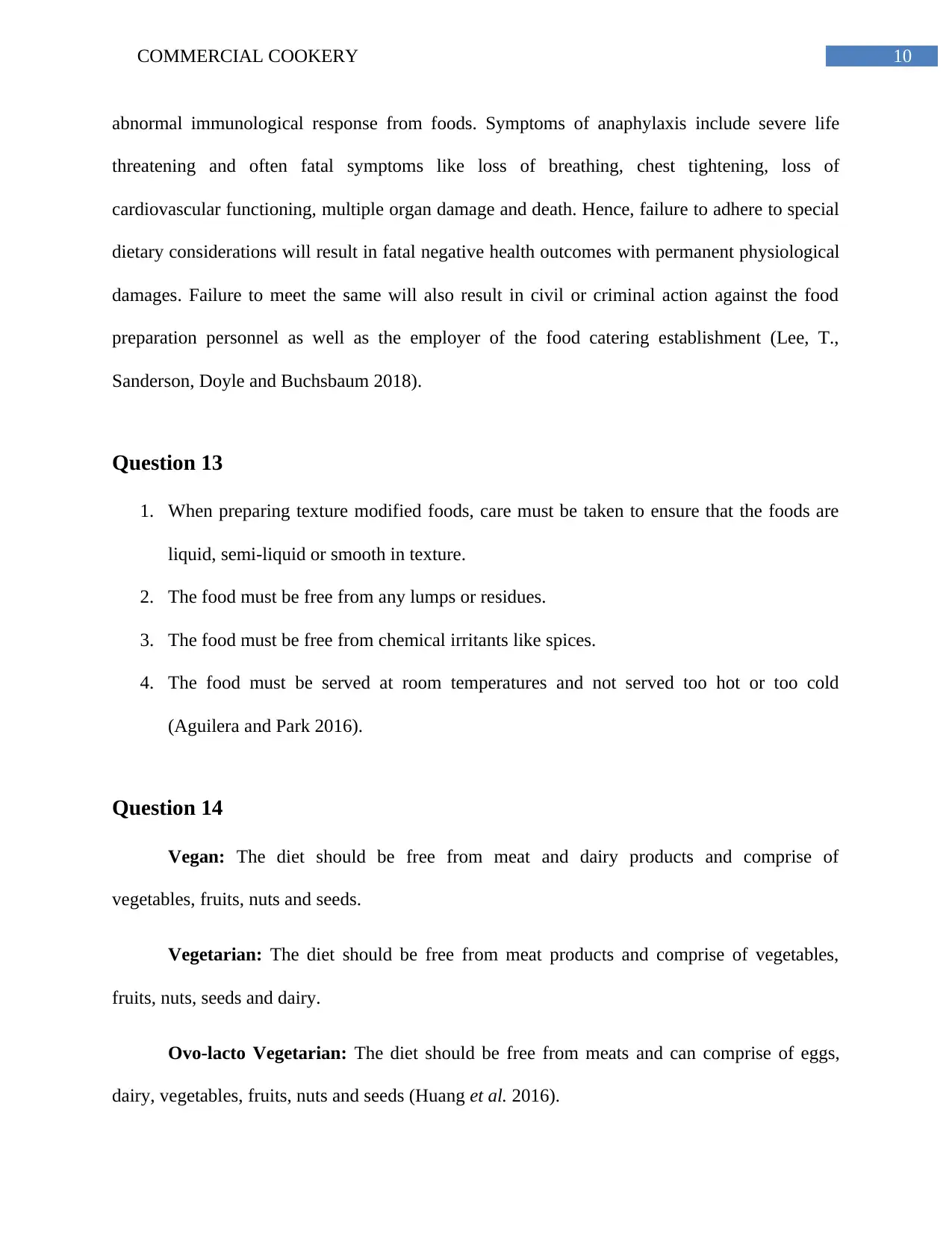
10COMMERCIAL COOKERY
abnormal immunological response from foods. Symptoms of anaphylaxis include severe life
threatening and often fatal symptoms like loss of breathing, chest tightening, loss of
cardiovascular functioning, multiple organ damage and death. Hence, failure to adhere to special
dietary considerations will result in fatal negative health outcomes with permanent physiological
damages. Failure to meet the same will also result in civil or criminal action against the food
preparation personnel as well as the employer of the food catering establishment (Lee, T.,
Sanderson, Doyle and Buchsbaum 2018).
Question 13
1. When preparing texture modified foods, care must be taken to ensure that the foods are
liquid, semi-liquid or smooth in texture.
2. The food must be free from any lumps or residues.
3. The food must be free from chemical irritants like spices.
4. The food must be served at room temperatures and not served too hot or too cold
(Aguilera and Park 2016).
Question 14
Vegan: The diet should be free from meat and dairy products and comprise of
vegetables, fruits, nuts and seeds.
Vegetarian: The diet should be free from meat products and comprise of vegetables,
fruits, nuts, seeds and dairy.
Ovo-lacto Vegetarian: The diet should be free from meats and can comprise of eggs,
dairy, vegetables, fruits, nuts and seeds (Huang et al. 2016).
abnormal immunological response from foods. Symptoms of anaphylaxis include severe life
threatening and often fatal symptoms like loss of breathing, chest tightening, loss of
cardiovascular functioning, multiple organ damage and death. Hence, failure to adhere to special
dietary considerations will result in fatal negative health outcomes with permanent physiological
damages. Failure to meet the same will also result in civil or criminal action against the food
preparation personnel as well as the employer of the food catering establishment (Lee, T.,
Sanderson, Doyle and Buchsbaum 2018).
Question 13
1. When preparing texture modified foods, care must be taken to ensure that the foods are
liquid, semi-liquid or smooth in texture.
2. The food must be free from any lumps or residues.
3. The food must be free from chemical irritants like spices.
4. The food must be served at room temperatures and not served too hot or too cold
(Aguilera and Park 2016).
Question 14
Vegan: The diet should be free from meat and dairy products and comprise of
vegetables, fruits, nuts and seeds.
Vegetarian: The diet should be free from meat products and comprise of vegetables,
fruits, nuts, seeds and dairy.
Ovo-lacto Vegetarian: The diet should be free from meats and can comprise of eggs,
dairy, vegetables, fruits, nuts and seeds (Huang et al. 2016).
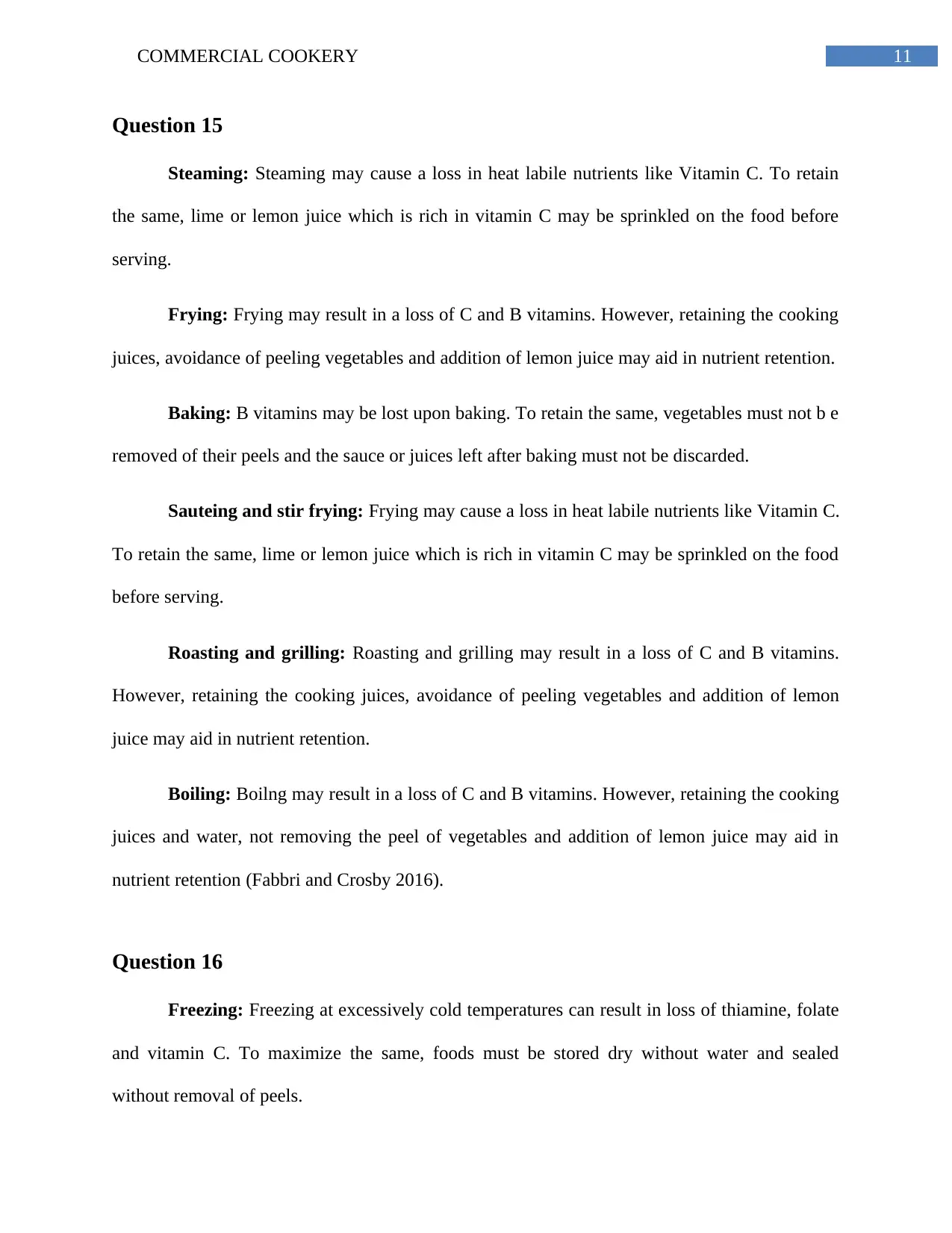
11COMMERCIAL COOKERY
Question 15
Steaming: Steaming may cause a loss in heat labile nutrients like Vitamin C. To retain
the same, lime or lemon juice which is rich in vitamin C may be sprinkled on the food before
serving.
Frying: Frying may result in a loss of C and B vitamins. However, retaining the cooking
juices, avoidance of peeling vegetables and addition of lemon juice may aid in nutrient retention.
Baking: B vitamins may be lost upon baking. To retain the same, vegetables must not b e
removed of their peels and the sauce or juices left after baking must not be discarded.
Sauteing and stir frying: Frying may cause a loss in heat labile nutrients like Vitamin C.
To retain the same, lime or lemon juice which is rich in vitamin C may be sprinkled on the food
before serving.
Roasting and grilling: Roasting and grilling may result in a loss of C and B vitamins.
However, retaining the cooking juices, avoidance of peeling vegetables and addition of lemon
juice may aid in nutrient retention.
Boiling: Boilng may result in a loss of C and B vitamins. However, retaining the cooking
juices and water, not removing the peel of vegetables and addition of lemon juice may aid in
nutrient retention (Fabbri and Crosby 2016).
Question 16
Freezing: Freezing at excessively cold temperatures can result in loss of thiamine, folate
and vitamin C. To maximize the same, foods must be stored dry without water and sealed
without removal of peels.
Question 15
Steaming: Steaming may cause a loss in heat labile nutrients like Vitamin C. To retain
the same, lime or lemon juice which is rich in vitamin C may be sprinkled on the food before
serving.
Frying: Frying may result in a loss of C and B vitamins. However, retaining the cooking
juices, avoidance of peeling vegetables and addition of lemon juice may aid in nutrient retention.
Baking: B vitamins may be lost upon baking. To retain the same, vegetables must not b e
removed of their peels and the sauce or juices left after baking must not be discarded.
Sauteing and stir frying: Frying may cause a loss in heat labile nutrients like Vitamin C.
To retain the same, lime or lemon juice which is rich in vitamin C may be sprinkled on the food
before serving.
Roasting and grilling: Roasting and grilling may result in a loss of C and B vitamins.
However, retaining the cooking juices, avoidance of peeling vegetables and addition of lemon
juice may aid in nutrient retention.
Boiling: Boilng may result in a loss of C and B vitamins. However, retaining the cooking
juices and water, not removing the peel of vegetables and addition of lemon juice may aid in
nutrient retention (Fabbri and Crosby 2016).
Question 16
Freezing: Freezing at excessively cold temperatures can result in loss of thiamine, folate
and vitamin C. To maximize the same, foods must be stored dry without water and sealed
without removal of peels.
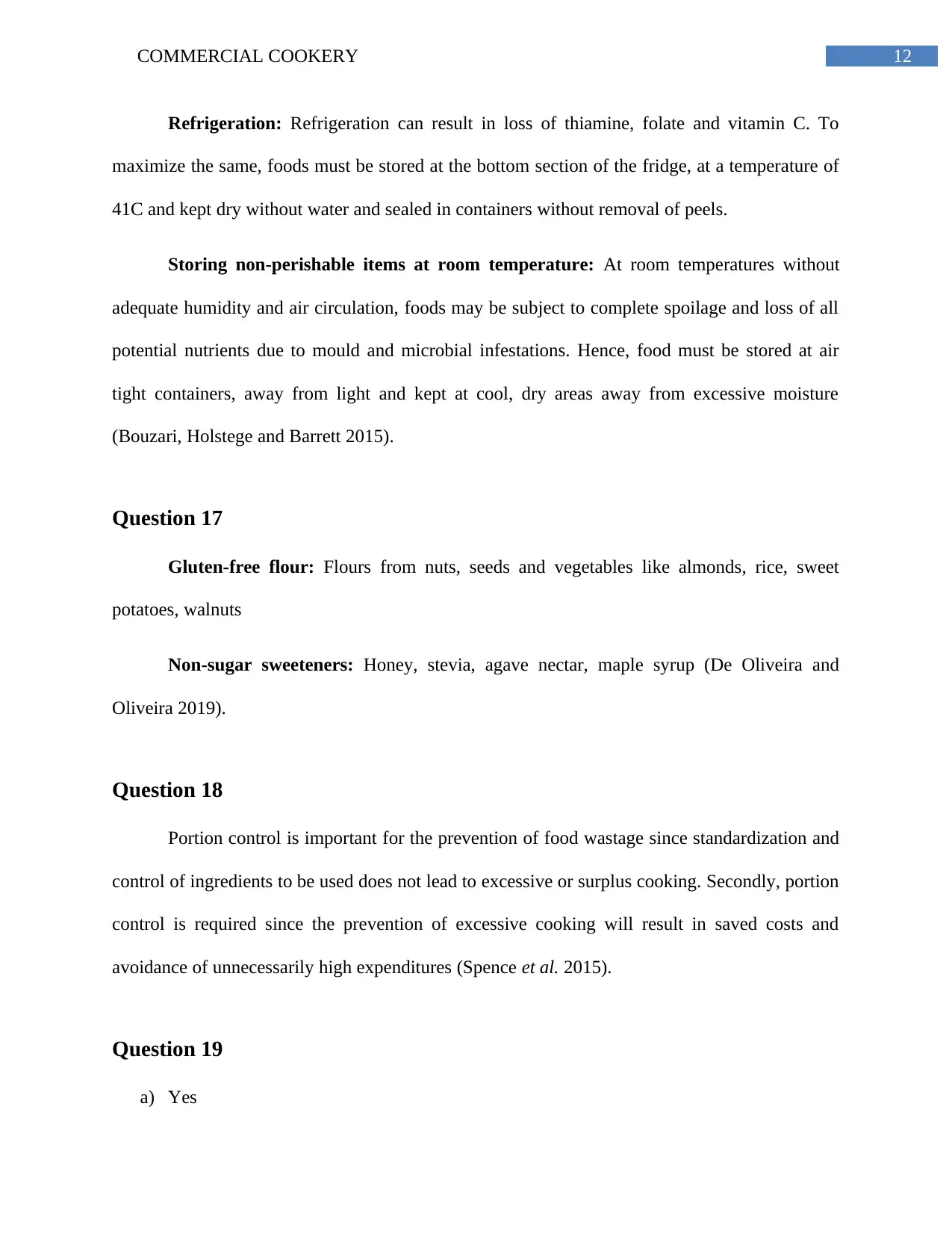
12COMMERCIAL COOKERY
Refrigeration: Refrigeration can result in loss of thiamine, folate and vitamin C. To
maximize the same, foods must be stored at the bottom section of the fridge, at a temperature of
41C and kept dry without water and sealed in containers without removal of peels.
Storing non-perishable items at room temperature: At room temperatures without
adequate humidity and air circulation, foods may be subject to complete spoilage and loss of all
potential nutrients due to mould and microbial infestations. Hence, food must be stored at air
tight containers, away from light and kept at cool, dry areas away from excessive moisture
(Bouzari, Holstege and Barrett 2015).
Question 17
Gluten-free flour: Flours from nuts, seeds and vegetables like almonds, rice, sweet
potatoes, walnuts
Non-sugar sweeteners: Honey, stevia, agave nectar, maple syrup (De Oliveira and
Oliveira 2019).
Question 18
Portion control is important for the prevention of food wastage since standardization and
control of ingredients to be used does not lead to excessive or surplus cooking. Secondly, portion
control is required since the prevention of excessive cooking will result in saved costs and
avoidance of unnecessarily high expenditures (Spence et al. 2015).
Question 19
a) Yes
Refrigeration: Refrigeration can result in loss of thiamine, folate and vitamin C. To
maximize the same, foods must be stored at the bottom section of the fridge, at a temperature of
41C and kept dry without water and sealed in containers without removal of peels.
Storing non-perishable items at room temperature: At room temperatures without
adequate humidity and air circulation, foods may be subject to complete spoilage and loss of all
potential nutrients due to mould and microbial infestations. Hence, food must be stored at air
tight containers, away from light and kept at cool, dry areas away from excessive moisture
(Bouzari, Holstege and Barrett 2015).
Question 17
Gluten-free flour: Flours from nuts, seeds and vegetables like almonds, rice, sweet
potatoes, walnuts
Non-sugar sweeteners: Honey, stevia, agave nectar, maple syrup (De Oliveira and
Oliveira 2019).
Question 18
Portion control is important for the prevention of food wastage since standardization and
control of ingredients to be used does not lead to excessive or surplus cooking. Secondly, portion
control is required since the prevention of excessive cooking will result in saved costs and
avoidance of unnecessarily high expenditures (Spence et al. 2015).
Question 19
a) Yes
Paraphrase This Document
Need a fresh take? Get an instant paraphrase of this document with our AI Paraphraser
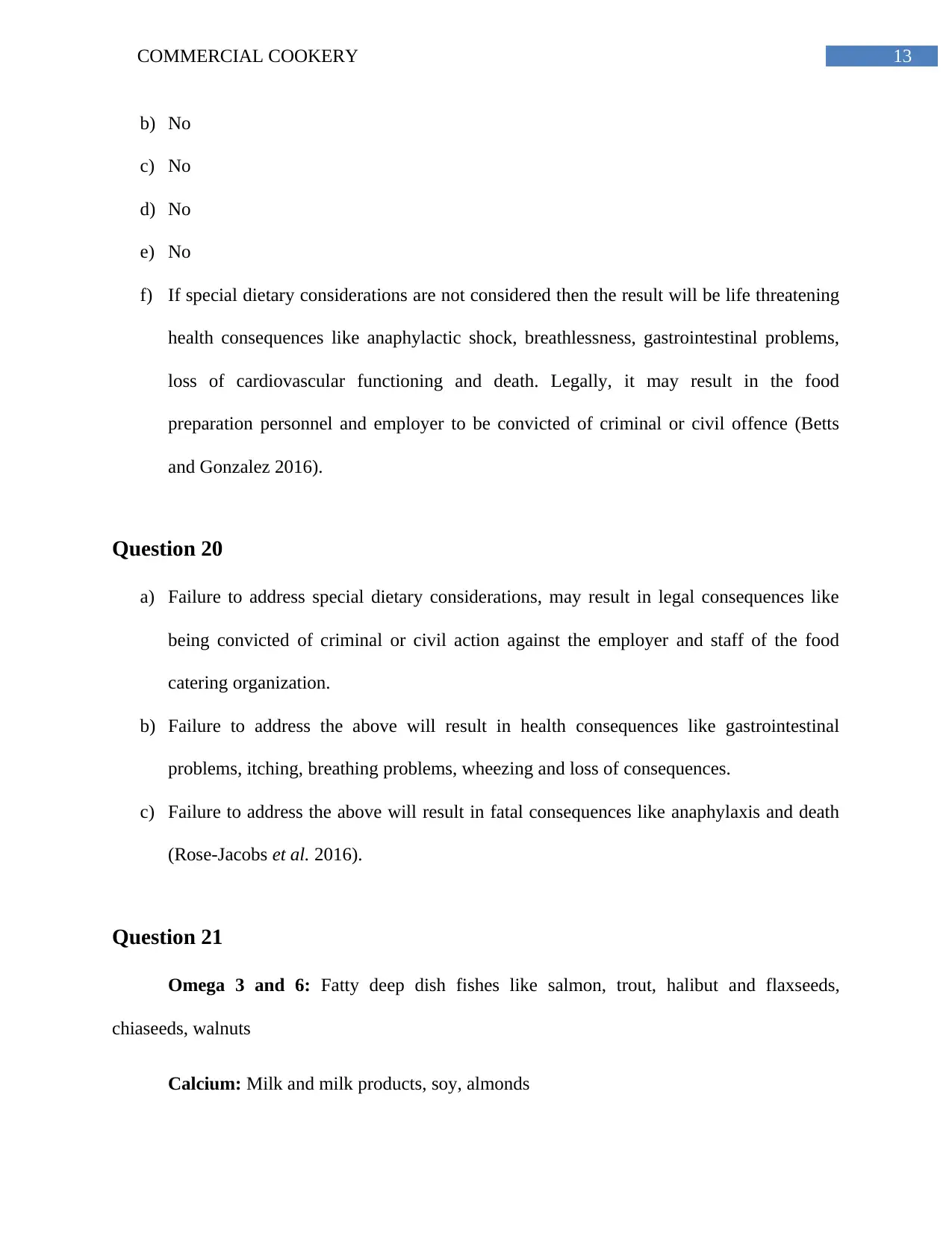
13COMMERCIAL COOKERY
b) No
c) No
d) No
e) No
f) If special dietary considerations are not considered then the result will be life threatening
health consequences like anaphylactic shock, breathlessness, gastrointestinal problems,
loss of cardiovascular functioning and death. Legally, it may result in the food
preparation personnel and employer to be convicted of criminal or civil offence (Betts
and Gonzalez 2016).
Question 20
a) Failure to address special dietary considerations, may result in legal consequences like
being convicted of criminal or civil action against the employer and staff of the food
catering organization.
b) Failure to address the above will result in health consequences like gastrointestinal
problems, itching, breathing problems, wheezing and loss of consequences.
c) Failure to address the above will result in fatal consequences like anaphylaxis and death
(Rose-Jacobs et al. 2016).
Question 21
Omega 3 and 6: Fatty deep dish fishes like salmon, trout, halibut and flaxseeds,
chiaseeds, walnuts
Calcium: Milk and milk products, soy, almonds
b) No
c) No
d) No
e) No
f) If special dietary considerations are not considered then the result will be life threatening
health consequences like anaphylactic shock, breathlessness, gastrointestinal problems,
loss of cardiovascular functioning and death. Legally, it may result in the food
preparation personnel and employer to be convicted of criminal or civil offence (Betts
and Gonzalez 2016).
Question 20
a) Failure to address special dietary considerations, may result in legal consequences like
being convicted of criminal or civil action against the employer and staff of the food
catering organization.
b) Failure to address the above will result in health consequences like gastrointestinal
problems, itching, breathing problems, wheezing and loss of consequences.
c) Failure to address the above will result in fatal consequences like anaphylaxis and death
(Rose-Jacobs et al. 2016).
Question 21
Omega 3 and 6: Fatty deep dish fishes like salmon, trout, halibut and flaxseeds,
chiaseeds, walnuts
Calcium: Milk and milk products, soy, almonds
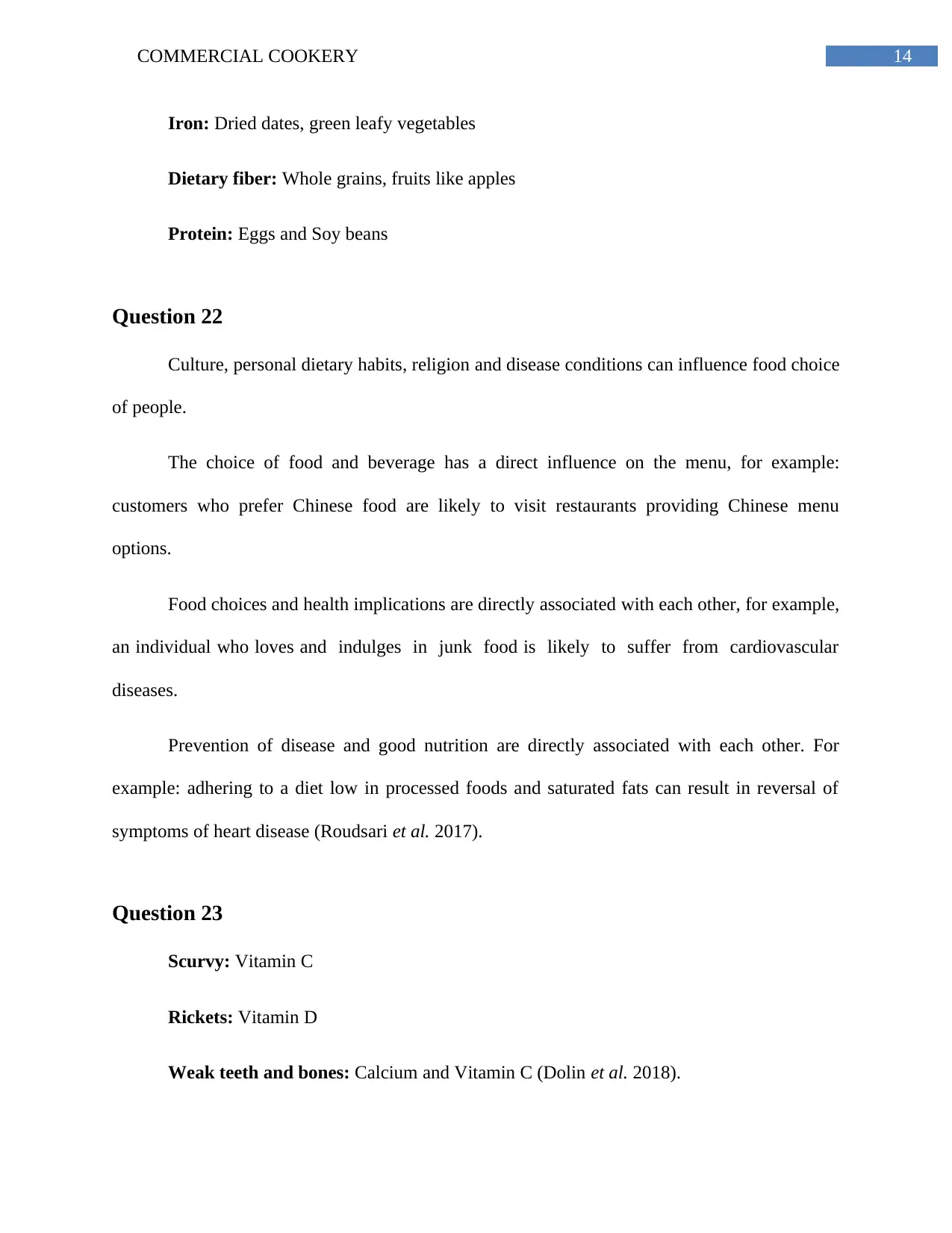
14COMMERCIAL COOKERY
Iron: Dried dates, green leafy vegetables
Dietary fiber: Whole grains, fruits like apples
Protein: Eggs and Soy beans
Question 22
Culture, personal dietary habits, religion and disease conditions can influence food choice
of people.
The choice of food and beverage has a direct influence on the menu, for example:
customers who prefer Chinese food are likely to visit restaurants providing Chinese menu
options.
Food choices and health implications are directly associated with each other, for example,
an individual who loves and indulges in junk food is likely to suffer from cardiovascular
diseases.
Prevention of disease and good nutrition are directly associated with each other. For
example: adhering to a diet low in processed foods and saturated fats can result in reversal of
symptoms of heart disease (Roudsari et al. 2017).
Question 23
Scurvy: Vitamin C
Rickets: Vitamin D
Weak teeth and bones: Calcium and Vitamin C (Dolin et al. 2018).
Iron: Dried dates, green leafy vegetables
Dietary fiber: Whole grains, fruits like apples
Protein: Eggs and Soy beans
Question 22
Culture, personal dietary habits, religion and disease conditions can influence food choice
of people.
The choice of food and beverage has a direct influence on the menu, for example:
customers who prefer Chinese food are likely to visit restaurants providing Chinese menu
options.
Food choices and health implications are directly associated with each other, for example,
an individual who loves and indulges in junk food is likely to suffer from cardiovascular
diseases.
Prevention of disease and good nutrition are directly associated with each other. For
example: adhering to a diet low in processed foods and saturated fats can result in reversal of
symptoms of heart disease (Roudsari et al. 2017).
Question 23
Scurvy: Vitamin C
Rickets: Vitamin D
Weak teeth and bones: Calcium and Vitamin C (Dolin et al. 2018).
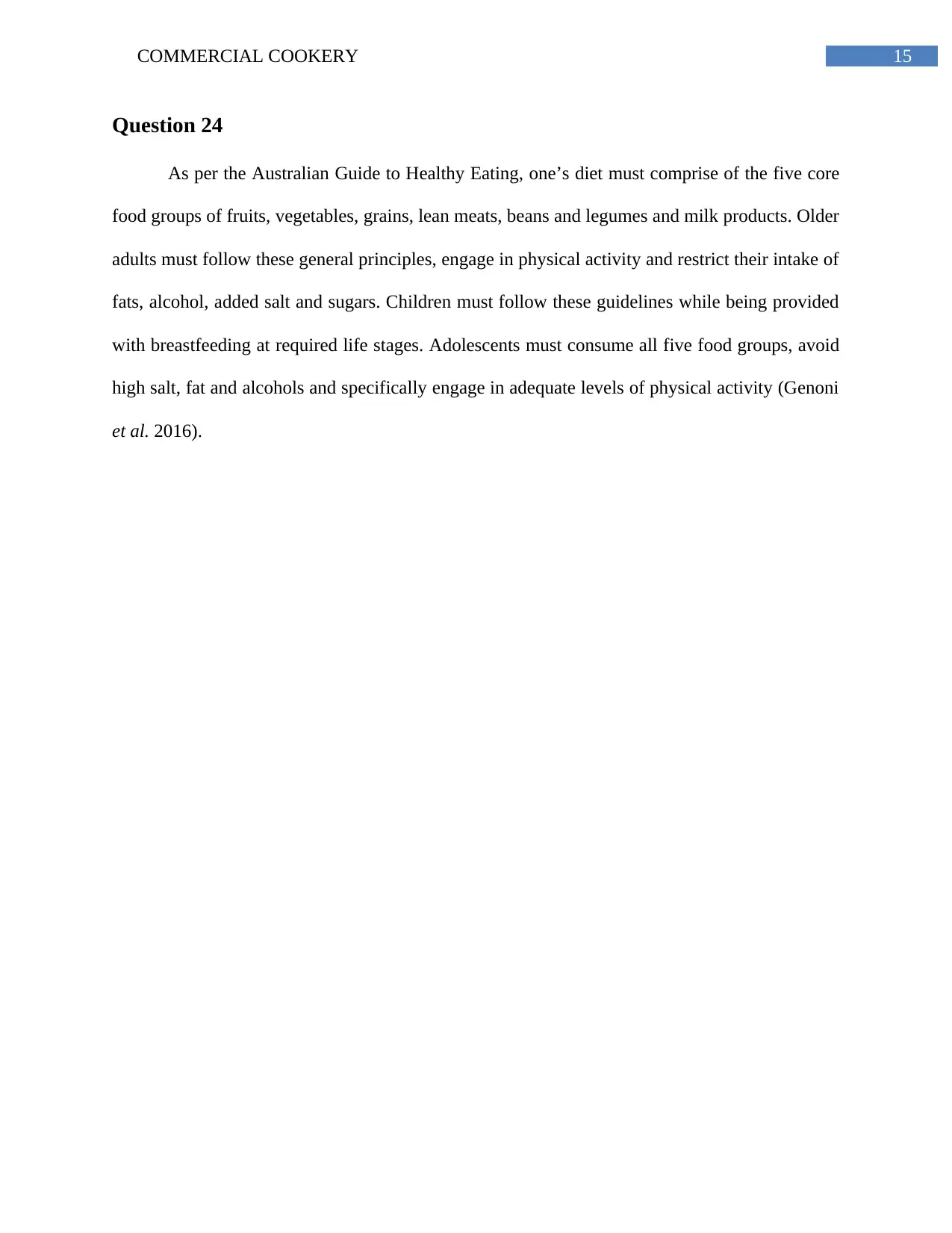
15COMMERCIAL COOKERY
Question 24
As per the Australian Guide to Healthy Eating, one’s diet must comprise of the five core
food groups of fruits, vegetables, grains, lean meats, beans and legumes and milk products. Older
adults must follow these general principles, engage in physical activity and restrict their intake of
fats, alcohol, added salt and sugars. Children must follow these guidelines while being provided
with breastfeeding at required life stages. Adolescents must consume all five food groups, avoid
high salt, fat and alcohols and specifically engage in adequate levels of physical activity (Genoni
et al. 2016).
Question 24
As per the Australian Guide to Healthy Eating, one’s diet must comprise of the five core
food groups of fruits, vegetables, grains, lean meats, beans and legumes and milk products. Older
adults must follow these general principles, engage in physical activity and restrict their intake of
fats, alcohol, added salt and sugars. Children must follow these guidelines while being provided
with breastfeeding at required life stages. Adolescents must consume all five food groups, avoid
high salt, fat and alcohols and specifically engage in adequate levels of physical activity (Genoni
et al. 2016).
Secure Best Marks with AI Grader
Need help grading? Try our AI Grader for instant feedback on your assignments.
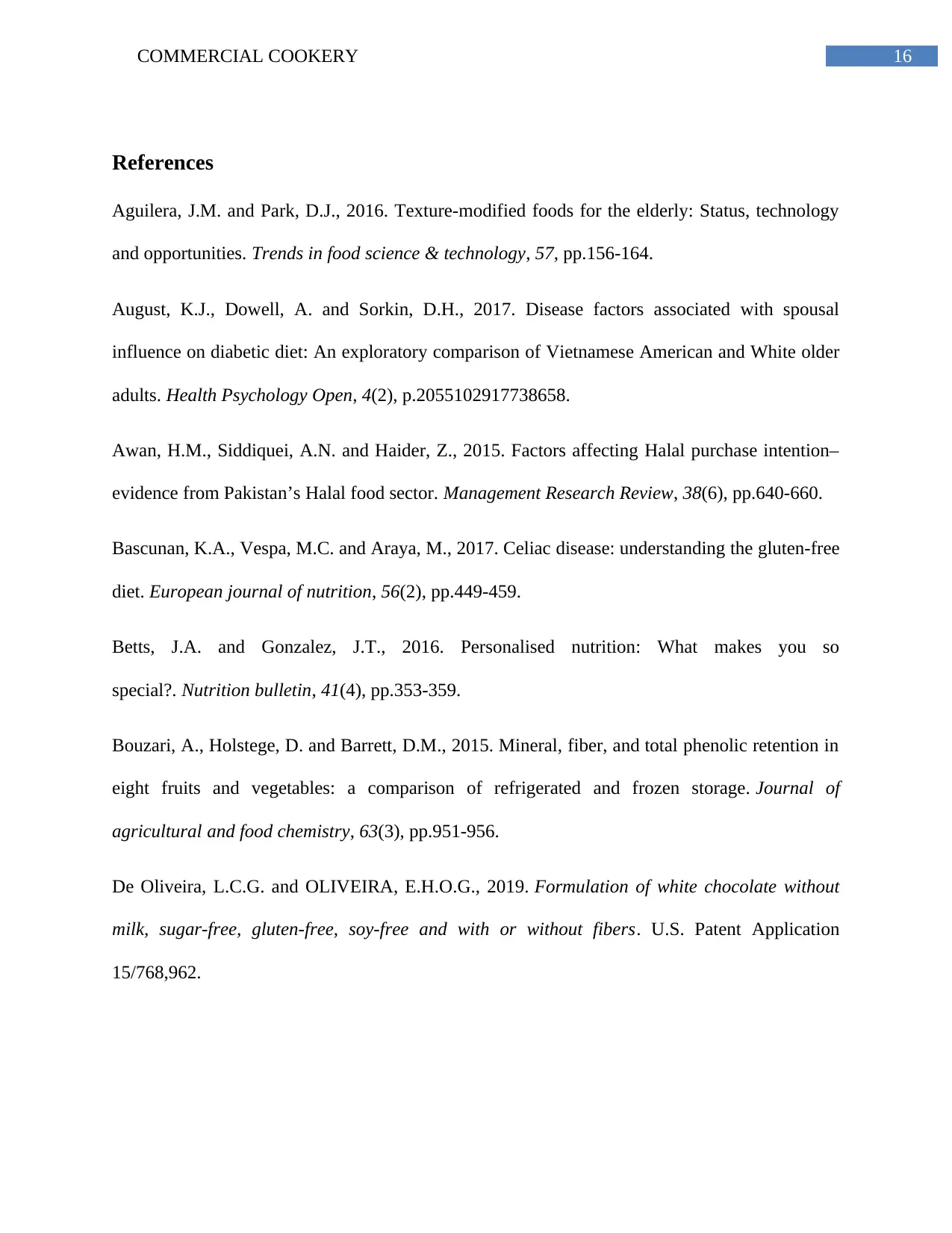
16COMMERCIAL COOKERY
References
Aguilera, J.M. and Park, D.J., 2016. Texture-modified foods for the elderly: Status, technology
and opportunities. Trends in food science & technology, 57, pp.156-164.
August, K.J., Dowell, A. and Sorkin, D.H., 2017. Disease factors associated with spousal
influence on diabetic diet: An exploratory comparison of Vietnamese American and White older
adults. Health Psychology Open, 4(2), p.2055102917738658.
Awan, H.M., Siddiquei, A.N. and Haider, Z., 2015. Factors affecting Halal purchase intention–
evidence from Pakistan’s Halal food sector. Management Research Review, 38(6), pp.640-660.
Bascunan, K.A., Vespa, M.C. and Araya, M., 2017. Celiac disease: understanding the gluten-free
diet. European journal of nutrition, 56(2), pp.449-459.
Betts, J.A. and Gonzalez, J.T., 2016. Personalised nutrition: What makes you so
special?. Nutrition bulletin, 41(4), pp.353-359.
Bouzari, A., Holstege, D. and Barrett, D.M., 2015. Mineral, fiber, and total phenolic retention in
eight fruits and vegetables: a comparison of refrigerated and frozen storage. Journal of
agricultural and food chemistry, 63(3), pp.951-956.
De Oliveira, L.C.G. and OLIVEIRA, E.H.O.G., 2019. Formulation of white chocolate without
milk, sugar-free, gluten-free, soy-free and with or without fibers. U.S. Patent Application
15/768,962.
References
Aguilera, J.M. and Park, D.J., 2016. Texture-modified foods for the elderly: Status, technology
and opportunities. Trends in food science & technology, 57, pp.156-164.
August, K.J., Dowell, A. and Sorkin, D.H., 2017. Disease factors associated with spousal
influence on diabetic diet: An exploratory comparison of Vietnamese American and White older
adults. Health Psychology Open, 4(2), p.2055102917738658.
Awan, H.M., Siddiquei, A.N. and Haider, Z., 2015. Factors affecting Halal purchase intention–
evidence from Pakistan’s Halal food sector. Management Research Review, 38(6), pp.640-660.
Bascunan, K.A., Vespa, M.C. and Araya, M., 2017. Celiac disease: understanding the gluten-free
diet. European journal of nutrition, 56(2), pp.449-459.
Betts, J.A. and Gonzalez, J.T., 2016. Personalised nutrition: What makes you so
special?. Nutrition bulletin, 41(4), pp.353-359.
Bouzari, A., Holstege, D. and Barrett, D.M., 2015. Mineral, fiber, and total phenolic retention in
eight fruits and vegetables: a comparison of refrigerated and frozen storage. Journal of
agricultural and food chemistry, 63(3), pp.951-956.
De Oliveira, L.C.G. and OLIVEIRA, E.H.O.G., 2019. Formulation of white chocolate without
milk, sugar-free, gluten-free, soy-free and with or without fibers. U.S. Patent Application
15/768,962.
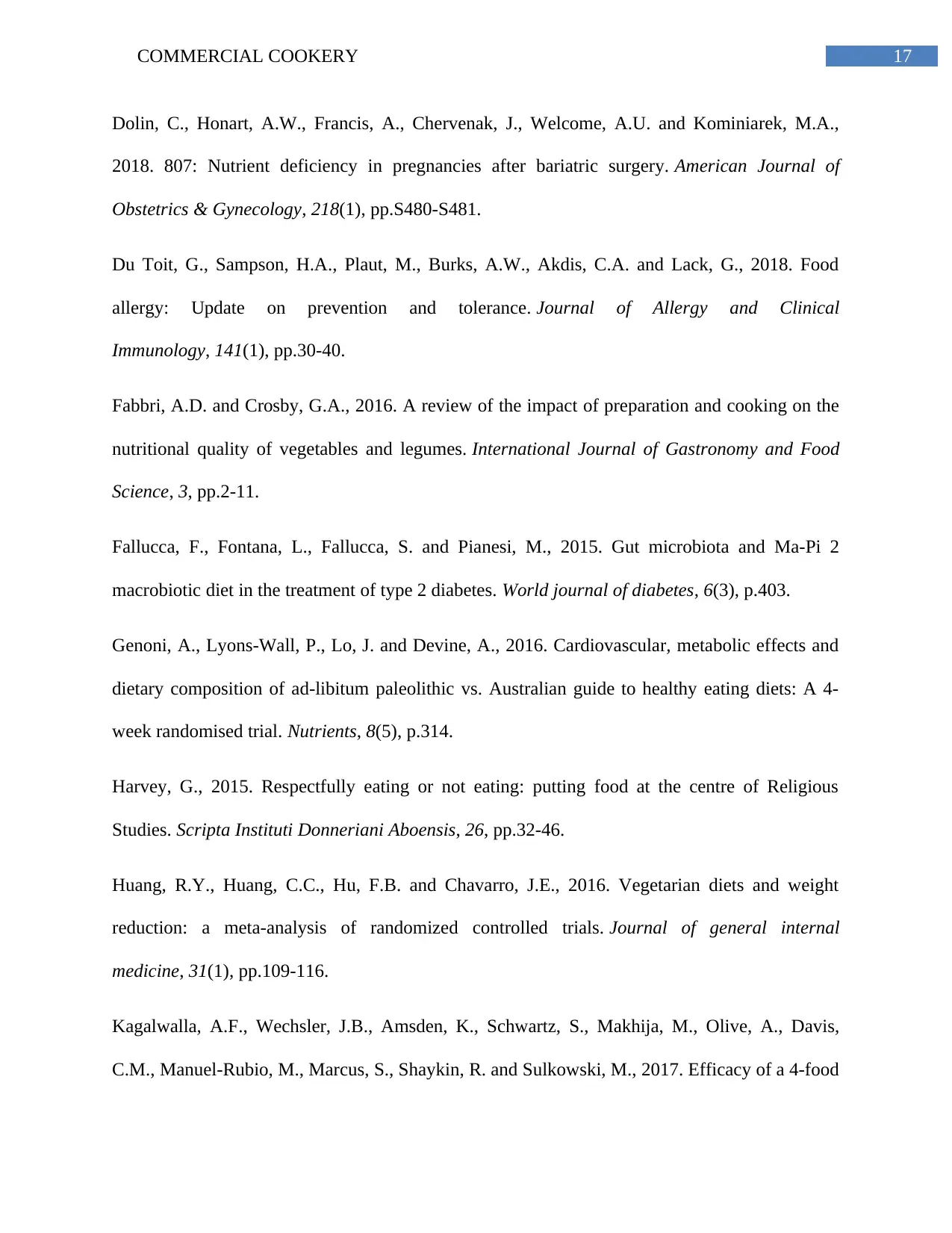
17COMMERCIAL COOKERY
Dolin, C., Honart, A.W., Francis, A., Chervenak, J., Welcome, A.U. and Kominiarek, M.A.,
2018. 807: Nutrient deficiency in pregnancies after bariatric surgery. American Journal of
Obstetrics & Gynecology, 218(1), pp.S480-S481.
Du Toit, G., Sampson, H.A., Plaut, M., Burks, A.W., Akdis, C.A. and Lack, G., 2018. Food
allergy: Update on prevention and tolerance. Journal of Allergy and Clinical
Immunology, 141(1), pp.30-40.
Fabbri, A.D. and Crosby, G.A., 2016. A review of the impact of preparation and cooking on the
nutritional quality of vegetables and legumes. International Journal of Gastronomy and Food
Science, 3, pp.2-11.
Fallucca, F., Fontana, L., Fallucca, S. and Pianesi, M., 2015. Gut microbiota and Ma-Pi 2
macrobiotic diet in the treatment of type 2 diabetes. World journal of diabetes, 6(3), p.403.
Genoni, A., Lyons-Wall, P., Lo, J. and Devine, A., 2016. Cardiovascular, metabolic effects and
dietary composition of ad-libitum paleolithic vs. Australian guide to healthy eating diets: A 4-
week randomised trial. Nutrients, 8(5), p.314.
Harvey, G., 2015. Respectfully eating or not eating: putting food at the centre of Religious
Studies. Scripta Instituti Donneriani Aboensis, 26, pp.32-46.
Huang, R.Y., Huang, C.C., Hu, F.B. and Chavarro, J.E., 2016. Vegetarian diets and weight
reduction: a meta-analysis of randomized controlled trials. Journal of general internal
medicine, 31(1), pp.109-116.
Kagalwalla, A.F., Wechsler, J.B., Amsden, K., Schwartz, S., Makhija, M., Olive, A., Davis,
C.M., Manuel-Rubio, M., Marcus, S., Shaykin, R. and Sulkowski, M., 2017. Efficacy of a 4-food
Dolin, C., Honart, A.W., Francis, A., Chervenak, J., Welcome, A.U. and Kominiarek, M.A.,
2018. 807: Nutrient deficiency in pregnancies after bariatric surgery. American Journal of
Obstetrics & Gynecology, 218(1), pp.S480-S481.
Du Toit, G., Sampson, H.A., Plaut, M., Burks, A.W., Akdis, C.A. and Lack, G., 2018. Food
allergy: Update on prevention and tolerance. Journal of Allergy and Clinical
Immunology, 141(1), pp.30-40.
Fabbri, A.D. and Crosby, G.A., 2016. A review of the impact of preparation and cooking on the
nutritional quality of vegetables and legumes. International Journal of Gastronomy and Food
Science, 3, pp.2-11.
Fallucca, F., Fontana, L., Fallucca, S. and Pianesi, M., 2015. Gut microbiota and Ma-Pi 2
macrobiotic diet in the treatment of type 2 diabetes. World journal of diabetes, 6(3), p.403.
Genoni, A., Lyons-Wall, P., Lo, J. and Devine, A., 2016. Cardiovascular, metabolic effects and
dietary composition of ad-libitum paleolithic vs. Australian guide to healthy eating diets: A 4-
week randomised trial. Nutrients, 8(5), p.314.
Harvey, G., 2015. Respectfully eating or not eating: putting food at the centre of Religious
Studies. Scripta Instituti Donneriani Aboensis, 26, pp.32-46.
Huang, R.Y., Huang, C.C., Hu, F.B. and Chavarro, J.E., 2016. Vegetarian diets and weight
reduction: a meta-analysis of randomized controlled trials. Journal of general internal
medicine, 31(1), pp.109-116.
Kagalwalla, A.F., Wechsler, J.B., Amsden, K., Schwartz, S., Makhija, M., Olive, A., Davis,
C.M., Manuel-Rubio, M., Marcus, S., Shaykin, R. and Sulkowski, M., 2017. Efficacy of a 4-food
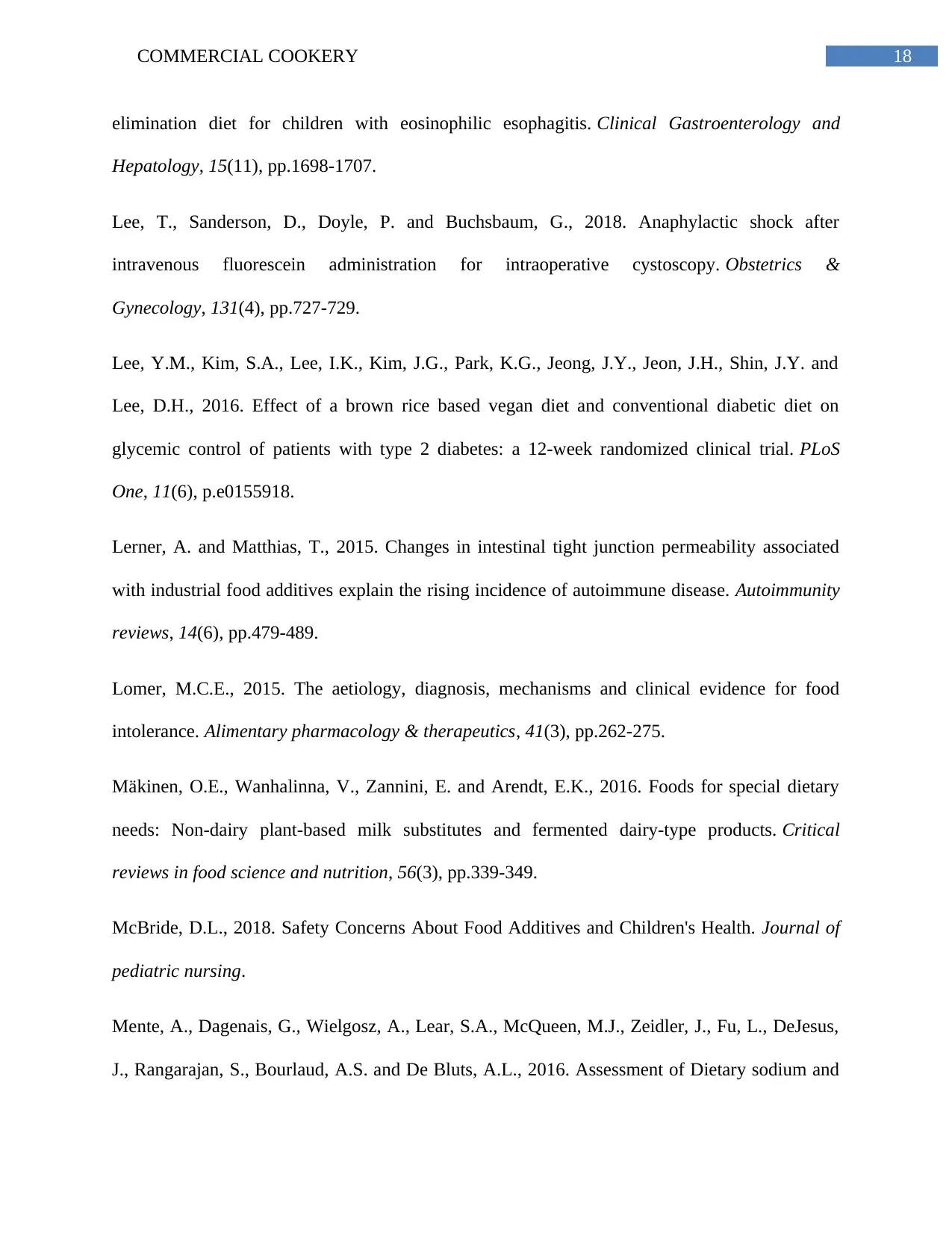
18COMMERCIAL COOKERY
elimination diet for children with eosinophilic esophagitis. Clinical Gastroenterology and
Hepatology, 15(11), pp.1698-1707.
Lee, T., Sanderson, D., Doyle, P. and Buchsbaum, G., 2018. Anaphylactic shock after
intravenous fluorescein administration for intraoperative cystoscopy. Obstetrics &
Gynecology, 131(4), pp.727-729.
Lee, Y.M., Kim, S.A., Lee, I.K., Kim, J.G., Park, K.G., Jeong, J.Y., Jeon, J.H., Shin, J.Y. and
Lee, D.H., 2016. Effect of a brown rice based vegan diet and conventional diabetic diet on
glycemic control of patients with type 2 diabetes: a 12-week randomized clinical trial. PLoS
One, 11(6), p.e0155918.
Lerner, A. and Matthias, T., 2015. Changes in intestinal tight junction permeability associated
with industrial food additives explain the rising incidence of autoimmune disease. Autoimmunity
reviews, 14(6), pp.479-489.
Lomer, M.C.E., 2015. The aetiology, diagnosis, mechanisms and clinical evidence for food
intolerance. Alimentary pharmacology & therapeutics, 41(3), pp.262-275.
Mäkinen, O.E., Wanhalinna, V., Zannini, E. and Arendt, E.K., 2016. Foods for special dietary
needs: Non-dairy plant-based milk substitutes and fermented dairy-type products. Critical
reviews in food science and nutrition, 56(3), pp.339-349.
McBride, D.L., 2018. Safety Concerns About Food Additives and Children's Health. Journal of
pediatric nursing.
Mente, A., Dagenais, G., Wielgosz, A., Lear, S.A., McQueen, M.J., Zeidler, J., Fu, L., DeJesus,
J., Rangarajan, S., Bourlaud, A.S. and De Bluts, A.L., 2016. Assessment of Dietary sodium and
elimination diet for children with eosinophilic esophagitis. Clinical Gastroenterology and
Hepatology, 15(11), pp.1698-1707.
Lee, T., Sanderson, D., Doyle, P. and Buchsbaum, G., 2018. Anaphylactic shock after
intravenous fluorescein administration for intraoperative cystoscopy. Obstetrics &
Gynecology, 131(4), pp.727-729.
Lee, Y.M., Kim, S.A., Lee, I.K., Kim, J.G., Park, K.G., Jeong, J.Y., Jeon, J.H., Shin, J.Y. and
Lee, D.H., 2016. Effect of a brown rice based vegan diet and conventional diabetic diet on
glycemic control of patients with type 2 diabetes: a 12-week randomized clinical trial. PLoS
One, 11(6), p.e0155918.
Lerner, A. and Matthias, T., 2015. Changes in intestinal tight junction permeability associated
with industrial food additives explain the rising incidence of autoimmune disease. Autoimmunity
reviews, 14(6), pp.479-489.
Lomer, M.C.E., 2015. The aetiology, diagnosis, mechanisms and clinical evidence for food
intolerance. Alimentary pharmacology & therapeutics, 41(3), pp.262-275.
Mäkinen, O.E., Wanhalinna, V., Zannini, E. and Arendt, E.K., 2016. Foods for special dietary
needs: Non-dairy plant-based milk substitutes and fermented dairy-type products. Critical
reviews in food science and nutrition, 56(3), pp.339-349.
McBride, D.L., 2018. Safety Concerns About Food Additives and Children's Health. Journal of
pediatric nursing.
Mente, A., Dagenais, G., Wielgosz, A., Lear, S.A., McQueen, M.J., Zeidler, J., Fu, L., DeJesus,
J., Rangarajan, S., Bourlaud, A.S. and De Bluts, A.L., 2016. Assessment of Dietary sodium and
Paraphrase This Document
Need a fresh take? Get an instant paraphrase of this document with our AI Paraphraser

19COMMERCIAL COOKERY
potassium in Canadians using 24-Hour urinary collection. Canadian Journal of
Cardiology, 32(3), pp.319-326.
Mohd Suki, N. and Mohd Suki, N., 2015. Does religion influence consumers’ green food
consumption? Some insights from Malaysia. Journal of Consumer Marketing, 32(7), pp.551-
563.
Morreale, F., Benavent-Gil, Y. and Rosell, C.M., 2019. Inulin enrichment of gluten free breads:
Interaction between inulin and yeast. Food chemistry, 278, pp.545-551.
Rehm, C.D. and Mozaffarian, D., 2015. Trends in Consumption of Key Foods and Nutrients
Linked to Cardiometabolic Risk Among Us Adults, 1999 to 2012. Circulation, 131(suppl_1),
pp.A15-A15.
Roca-Saavedra, P., Mendez-Vilabrille, V., Miranda, J.M., Nebot, C., Cardelle-Cobas, A., Franco,
C.M. and Cepeda, A., 2018. Food additives, contaminants and other minor components: effects
on human gut microbiota—a review. Journal of physiology and biochemistry, 74(1), pp.69-83.
Rose-Jacobs, R., Fiore, J.G., de Cuba, S.E., Black, M., Cutts, D.B., Coleman, S.M., Heeren, T.,
Chilton, M., Casey, P., Cook, J. and Frank, D.A., 2016. Children with special health care needs,
Supplemental Security Income, and food insecurity. Journal of Developmental & Behavioral
Pediatrics, 37(2), pp.140-147.
Roudsari, A.H., Vedadhir, A., Amiri, P., Kalantari, N., Omidvar, N., Eini-Zinab, H. and Sadati,
S.M.H., 2017. Psycho-socio-cultural determinants of food choice: A qualitative study on adults
in social and cultural context of Iran. Iranian journal of psychiatry, 12(4), p.241.
potassium in Canadians using 24-Hour urinary collection. Canadian Journal of
Cardiology, 32(3), pp.319-326.
Mohd Suki, N. and Mohd Suki, N., 2015. Does religion influence consumers’ green food
consumption? Some insights from Malaysia. Journal of Consumer Marketing, 32(7), pp.551-
563.
Morreale, F., Benavent-Gil, Y. and Rosell, C.M., 2019. Inulin enrichment of gluten free breads:
Interaction between inulin and yeast. Food chemistry, 278, pp.545-551.
Rehm, C.D. and Mozaffarian, D., 2015. Trends in Consumption of Key Foods and Nutrients
Linked to Cardiometabolic Risk Among Us Adults, 1999 to 2012. Circulation, 131(suppl_1),
pp.A15-A15.
Roca-Saavedra, P., Mendez-Vilabrille, V., Miranda, J.M., Nebot, C., Cardelle-Cobas, A., Franco,
C.M. and Cepeda, A., 2018. Food additives, contaminants and other minor components: effects
on human gut microbiota—a review. Journal of physiology and biochemistry, 74(1), pp.69-83.
Rose-Jacobs, R., Fiore, J.G., de Cuba, S.E., Black, M., Cutts, D.B., Coleman, S.M., Heeren, T.,
Chilton, M., Casey, P., Cook, J. and Frank, D.A., 2016. Children with special health care needs,
Supplemental Security Income, and food insecurity. Journal of Developmental & Behavioral
Pediatrics, 37(2), pp.140-147.
Roudsari, A.H., Vedadhir, A., Amiri, P., Kalantari, N., Omidvar, N., Eini-Zinab, H. and Sadati,
S.M.H., 2017. Psycho-socio-cultural determinants of food choice: A qualitative study on adults
in social and cultural context of Iran. Iranian journal of psychiatry, 12(4), p.241.
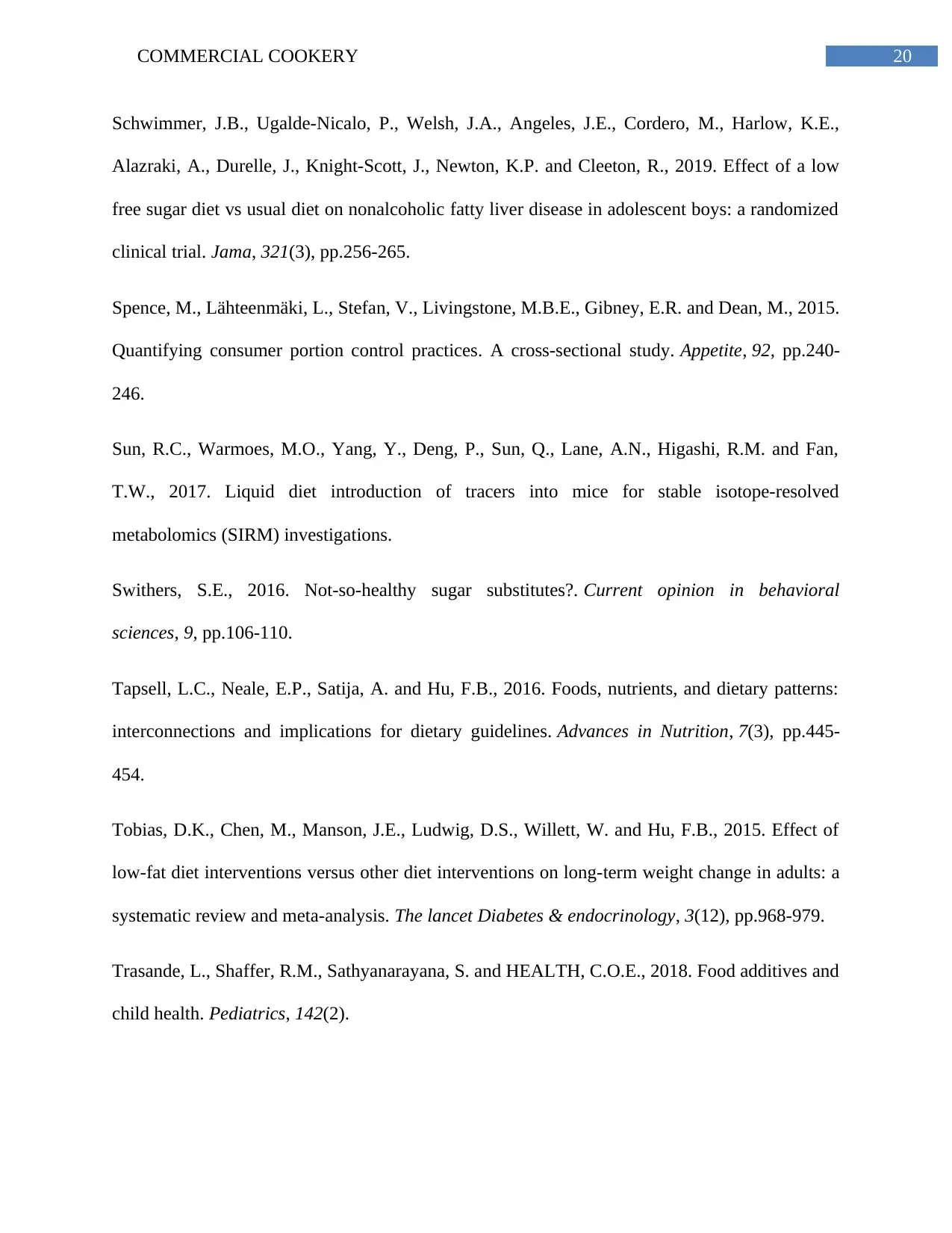
20COMMERCIAL COOKERY
Schwimmer, J.B., Ugalde-Nicalo, P., Welsh, J.A., Angeles, J.E., Cordero, M., Harlow, K.E.,
Alazraki, A., Durelle, J., Knight-Scott, J., Newton, K.P. and Cleeton, R., 2019. Effect of a low
free sugar diet vs usual diet on nonalcoholic fatty liver disease in adolescent boys: a randomized
clinical trial. Jama, 321(3), pp.256-265.
Spence, M., Lähteenmäki, L., Stefan, V., Livingstone, M.B.E., Gibney, E.R. and Dean, M., 2015.
Quantifying consumer portion control practices. A cross-sectional study. Appetite, 92, pp.240-
246.
Sun, R.C., Warmoes, M.O., Yang, Y., Deng, P., Sun, Q., Lane, A.N., Higashi, R.M. and Fan,
T.W., 2017. Liquid diet introduction of tracers into mice for stable isotope-resolved
metabolomics (SIRM) investigations.
Swithers, S.E., 2016. Not-so-healthy sugar substitutes?. Current opinion in behavioral
sciences, 9, pp.106-110.
Tapsell, L.C., Neale, E.P., Satija, A. and Hu, F.B., 2016. Foods, nutrients, and dietary patterns:
interconnections and implications for dietary guidelines. Advances in Nutrition, 7(3), pp.445-
454.
Tobias, D.K., Chen, M., Manson, J.E., Ludwig, D.S., Willett, W. and Hu, F.B., 2015. Effect of
low-fat diet interventions versus other diet interventions on long-term weight change in adults: a
systematic review and meta-analysis. The lancet Diabetes & endocrinology, 3(12), pp.968-979.
Trasande, L., Shaffer, R.M., Sathyanarayana, S. and HEALTH, C.O.E., 2018. Food additives and
child health. Pediatrics, 142(2).
Schwimmer, J.B., Ugalde-Nicalo, P., Welsh, J.A., Angeles, J.E., Cordero, M., Harlow, K.E.,
Alazraki, A., Durelle, J., Knight-Scott, J., Newton, K.P. and Cleeton, R., 2019. Effect of a low
free sugar diet vs usual diet on nonalcoholic fatty liver disease in adolescent boys: a randomized
clinical trial. Jama, 321(3), pp.256-265.
Spence, M., Lähteenmäki, L., Stefan, V., Livingstone, M.B.E., Gibney, E.R. and Dean, M., 2015.
Quantifying consumer portion control practices. A cross-sectional study. Appetite, 92, pp.240-
246.
Sun, R.C., Warmoes, M.O., Yang, Y., Deng, P., Sun, Q., Lane, A.N., Higashi, R.M. and Fan,
T.W., 2017. Liquid diet introduction of tracers into mice for stable isotope-resolved
metabolomics (SIRM) investigations.
Swithers, S.E., 2016. Not-so-healthy sugar substitutes?. Current opinion in behavioral
sciences, 9, pp.106-110.
Tapsell, L.C., Neale, E.P., Satija, A. and Hu, F.B., 2016. Foods, nutrients, and dietary patterns:
interconnections and implications for dietary guidelines. Advances in Nutrition, 7(3), pp.445-
454.
Tobias, D.K., Chen, M., Manson, J.E., Ludwig, D.S., Willett, W. and Hu, F.B., 2015. Effect of
low-fat diet interventions versus other diet interventions on long-term weight change in adults: a
systematic review and meta-analysis. The lancet Diabetes & endocrinology, 3(12), pp.968-979.
Trasande, L., Shaffer, R.M., Sathyanarayana, S. and HEALTH, C.O.E., 2018. Food additives and
child health. Pediatrics, 142(2).
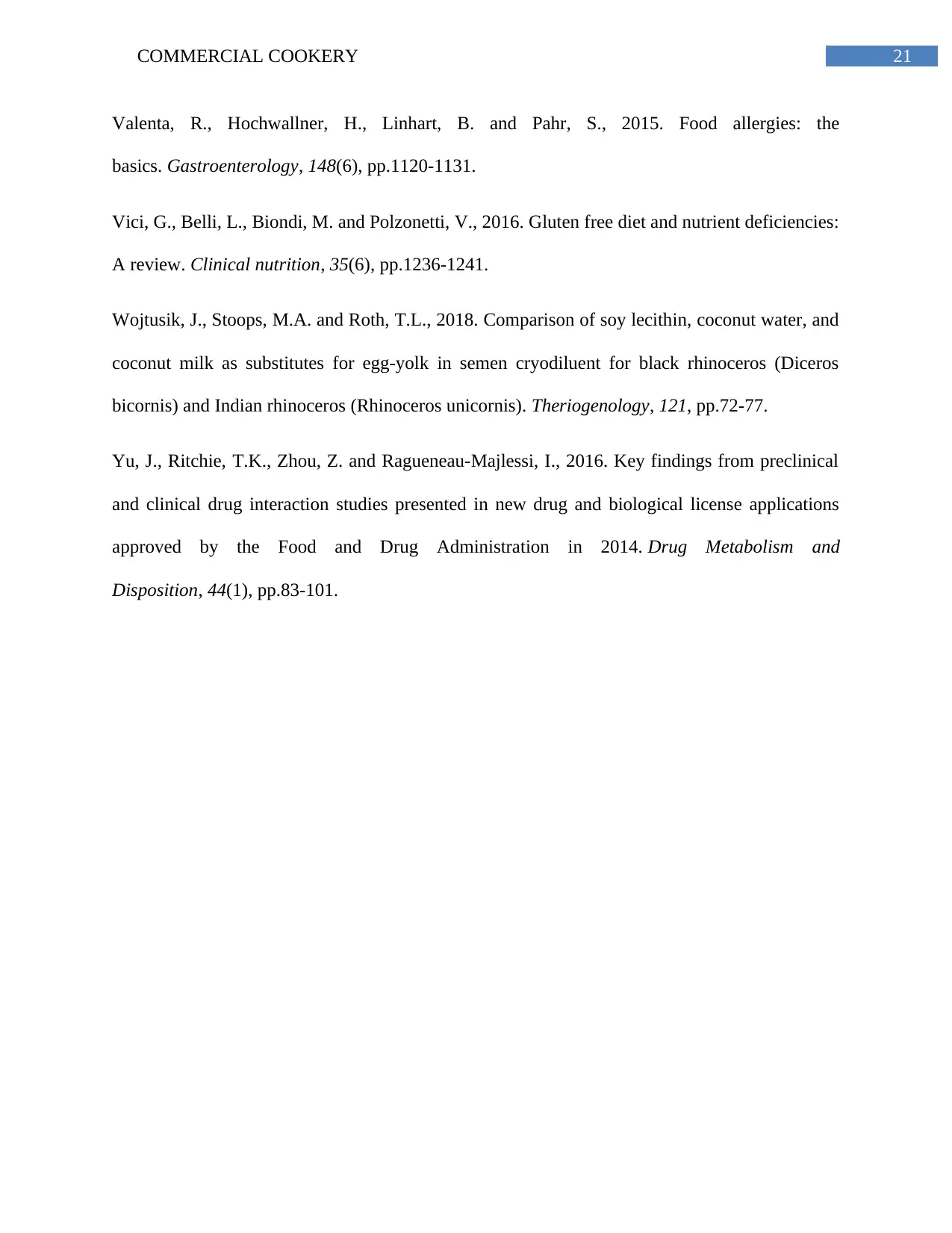
21COMMERCIAL COOKERY
Valenta, R., Hochwallner, H., Linhart, B. and Pahr, S., 2015. Food allergies: the
basics. Gastroenterology, 148(6), pp.1120-1131.
Vici, G., Belli, L., Biondi, M. and Polzonetti, V., 2016. Gluten free diet and nutrient deficiencies:
A review. Clinical nutrition, 35(6), pp.1236-1241.
Wojtusik, J., Stoops, M.A. and Roth, T.L., 2018. Comparison of soy lecithin, coconut water, and
coconut milk as substitutes for egg-yolk in semen cryodiluent for black rhinoceros (Diceros
bicornis) and Indian rhinoceros (Rhinoceros unicornis). Theriogenology, 121, pp.72-77.
Yu, J., Ritchie, T.K., Zhou, Z. and Ragueneau-Majlessi, I., 2016. Key findings from preclinical
and clinical drug interaction studies presented in new drug and biological license applications
approved by the Food and Drug Administration in 2014. Drug Metabolism and
Disposition, 44(1), pp.83-101.
Valenta, R., Hochwallner, H., Linhart, B. and Pahr, S., 2015. Food allergies: the
basics. Gastroenterology, 148(6), pp.1120-1131.
Vici, G., Belli, L., Biondi, M. and Polzonetti, V., 2016. Gluten free diet and nutrient deficiencies:
A review. Clinical nutrition, 35(6), pp.1236-1241.
Wojtusik, J., Stoops, M.A. and Roth, T.L., 2018. Comparison of soy lecithin, coconut water, and
coconut milk as substitutes for egg-yolk in semen cryodiluent for black rhinoceros (Diceros
bicornis) and Indian rhinoceros (Rhinoceros unicornis). Theriogenology, 121, pp.72-77.
Yu, J., Ritchie, T.K., Zhou, Z. and Ragueneau-Majlessi, I., 2016. Key findings from preclinical
and clinical drug interaction studies presented in new drug and biological license applications
approved by the Food and Drug Administration in 2014. Drug Metabolism and
Disposition, 44(1), pp.83-101.
1 out of 22
Your All-in-One AI-Powered Toolkit for Academic Success.
+13062052269
info@desklib.com
Available 24*7 on WhatsApp / Email
![[object Object]](/_next/static/media/star-bottom.7253800d.svg)
Unlock your academic potential
© 2024 | Zucol Services PVT LTD | All rights reserved.

